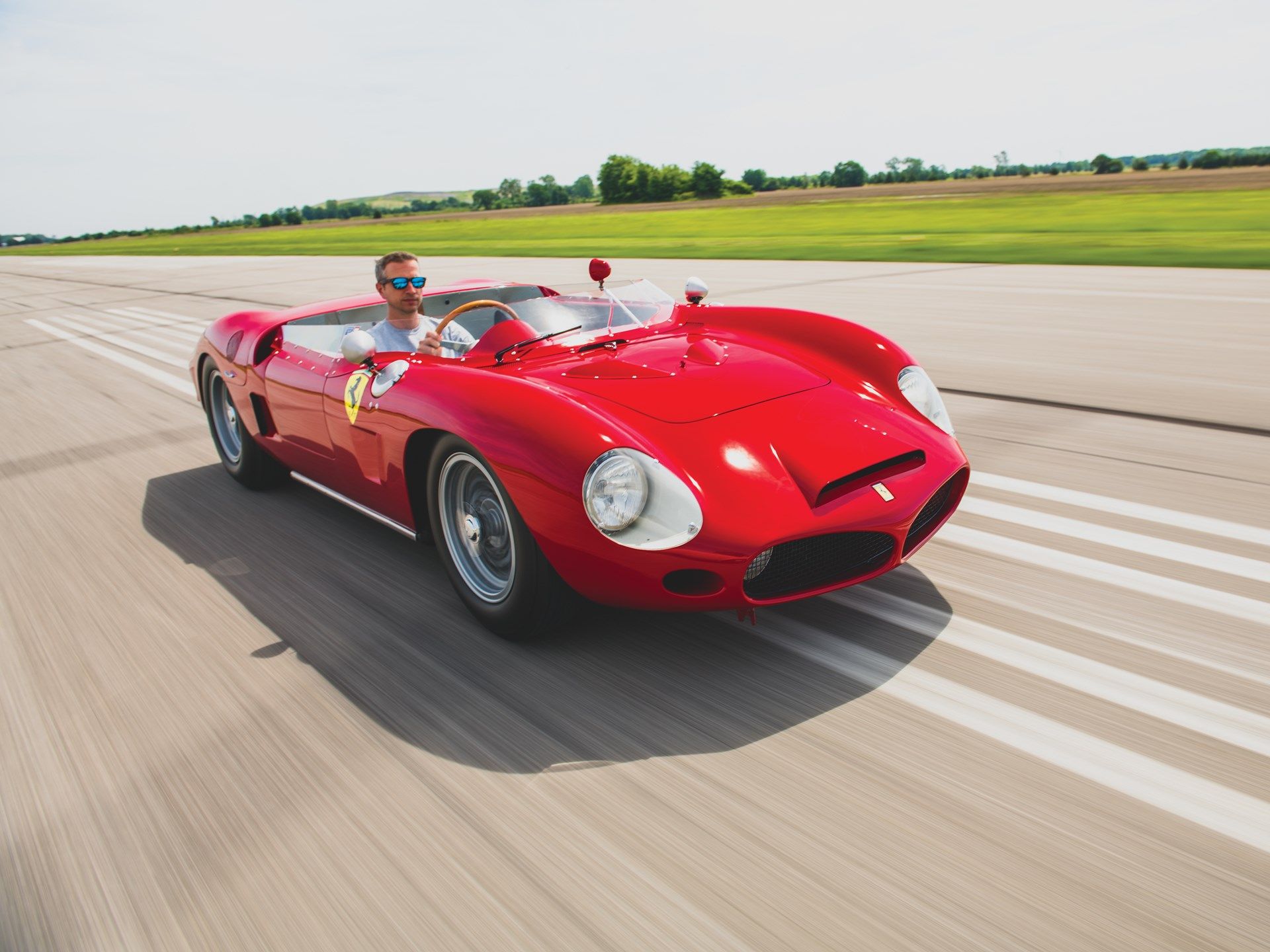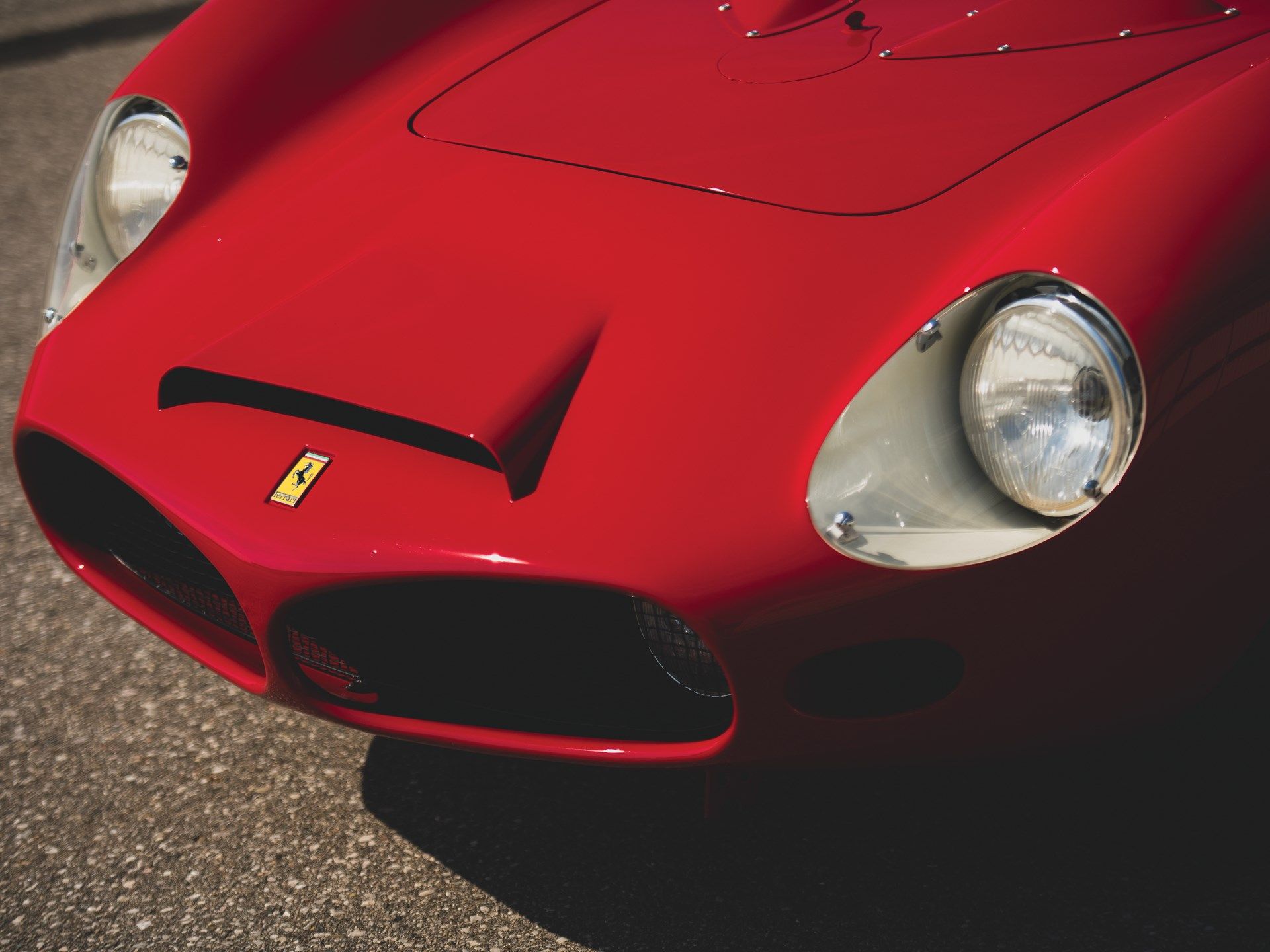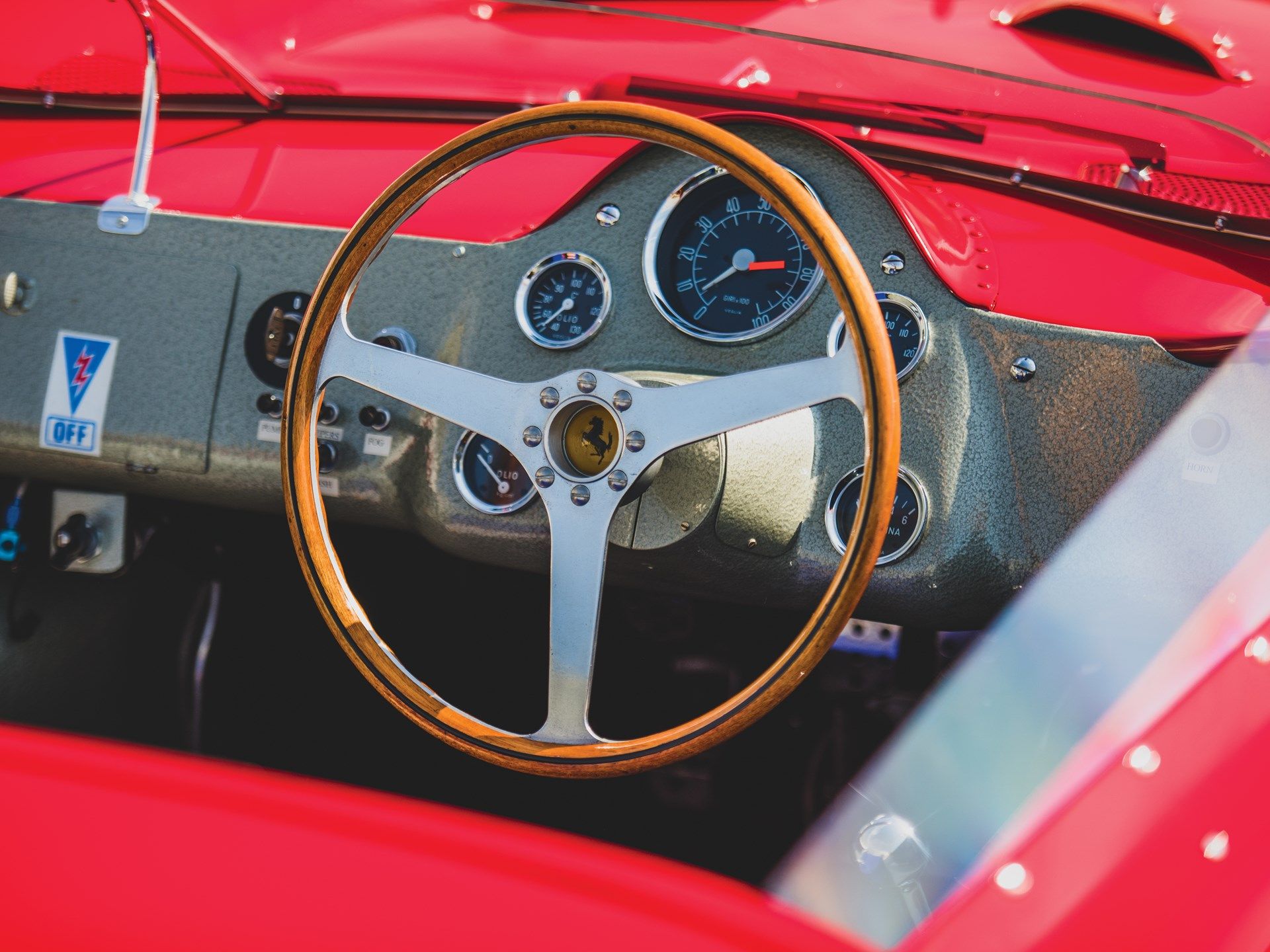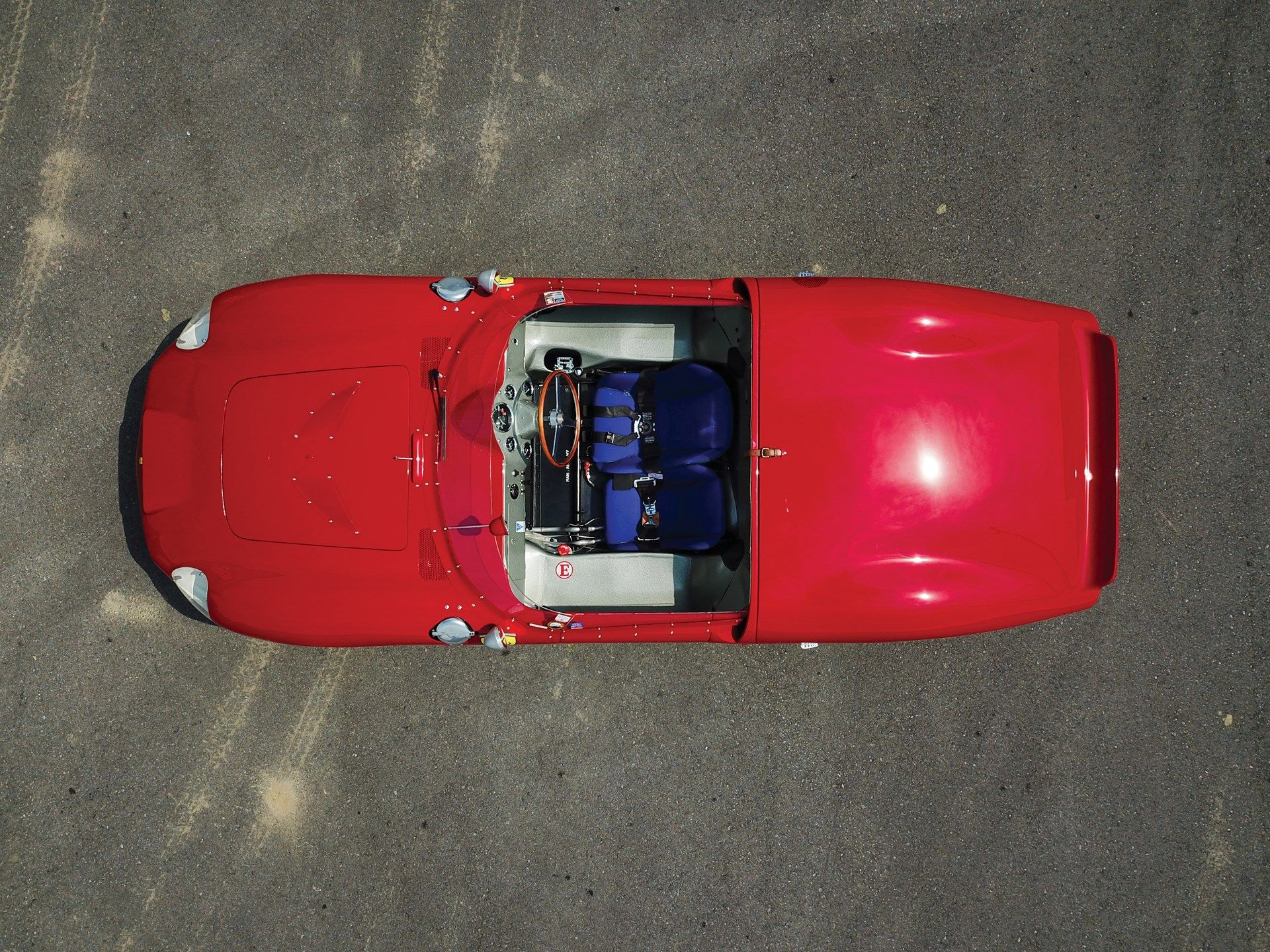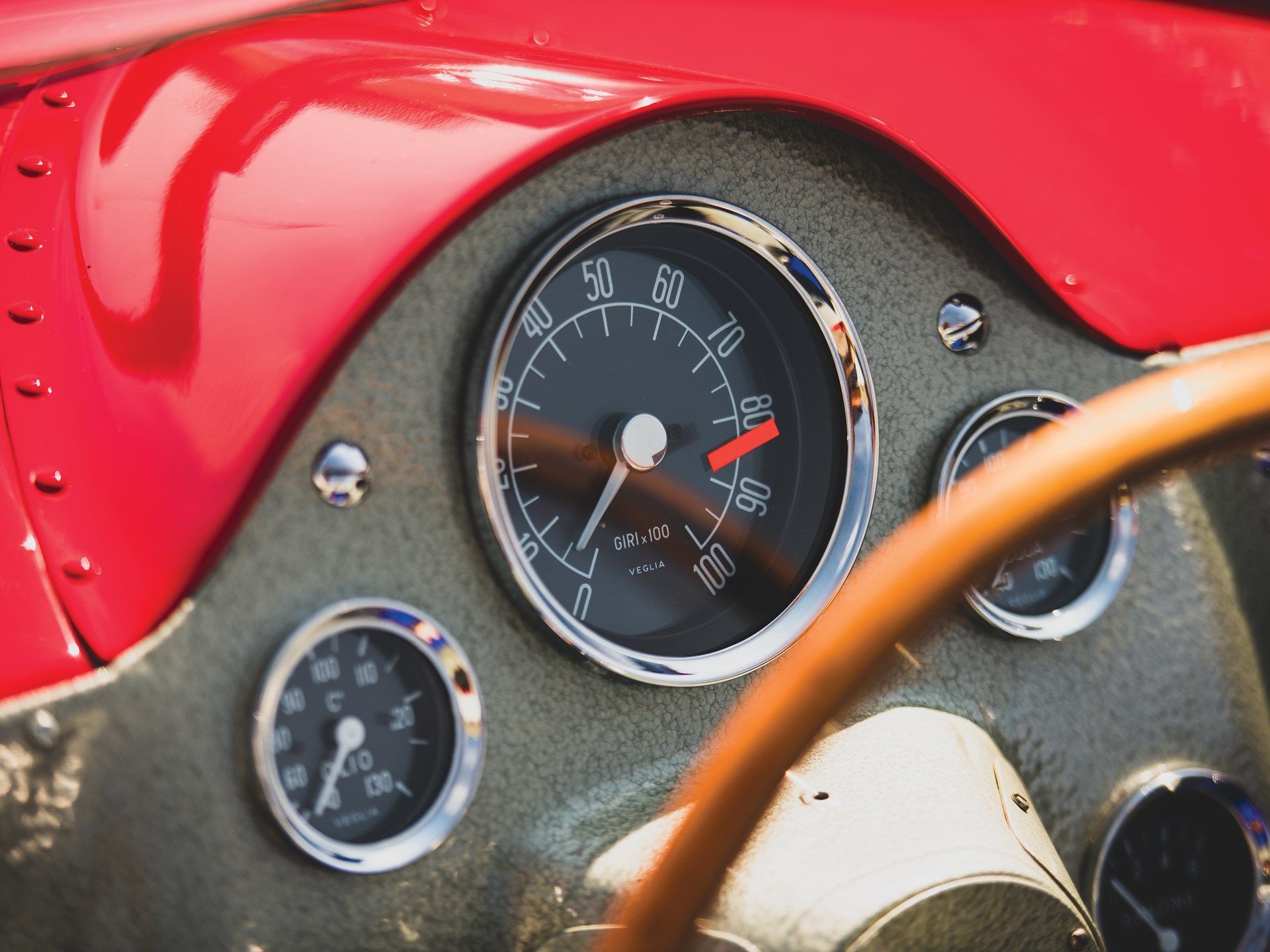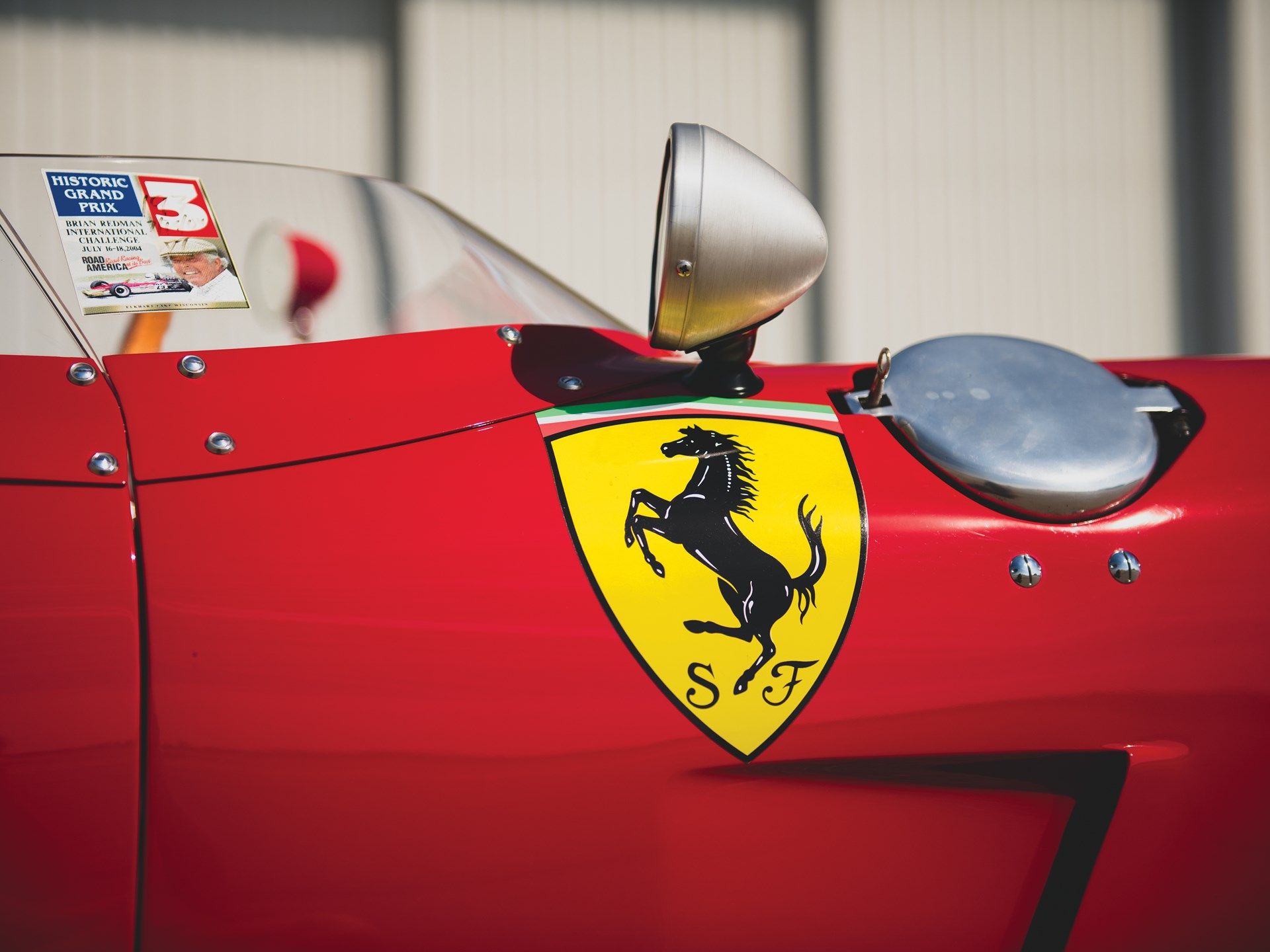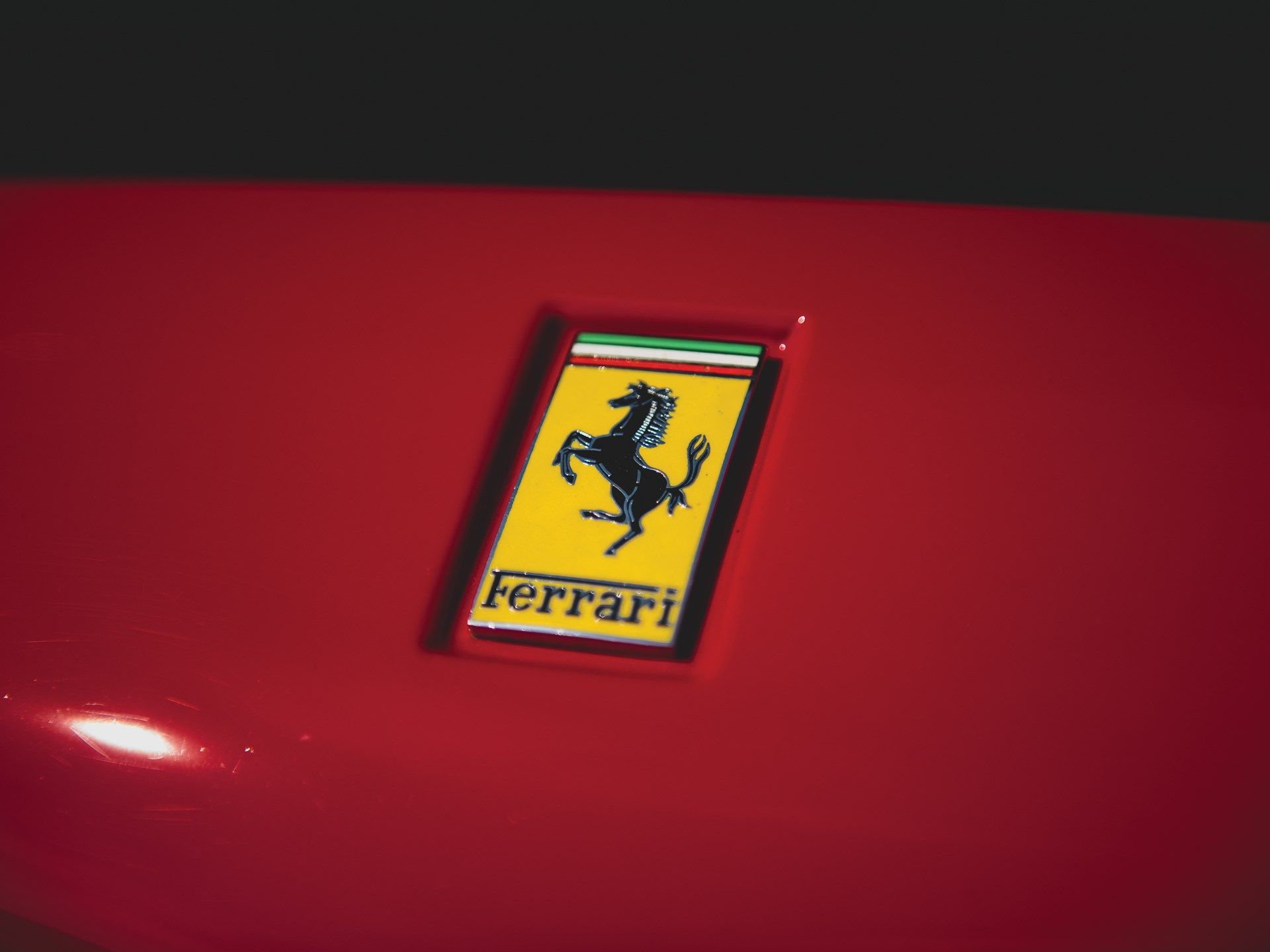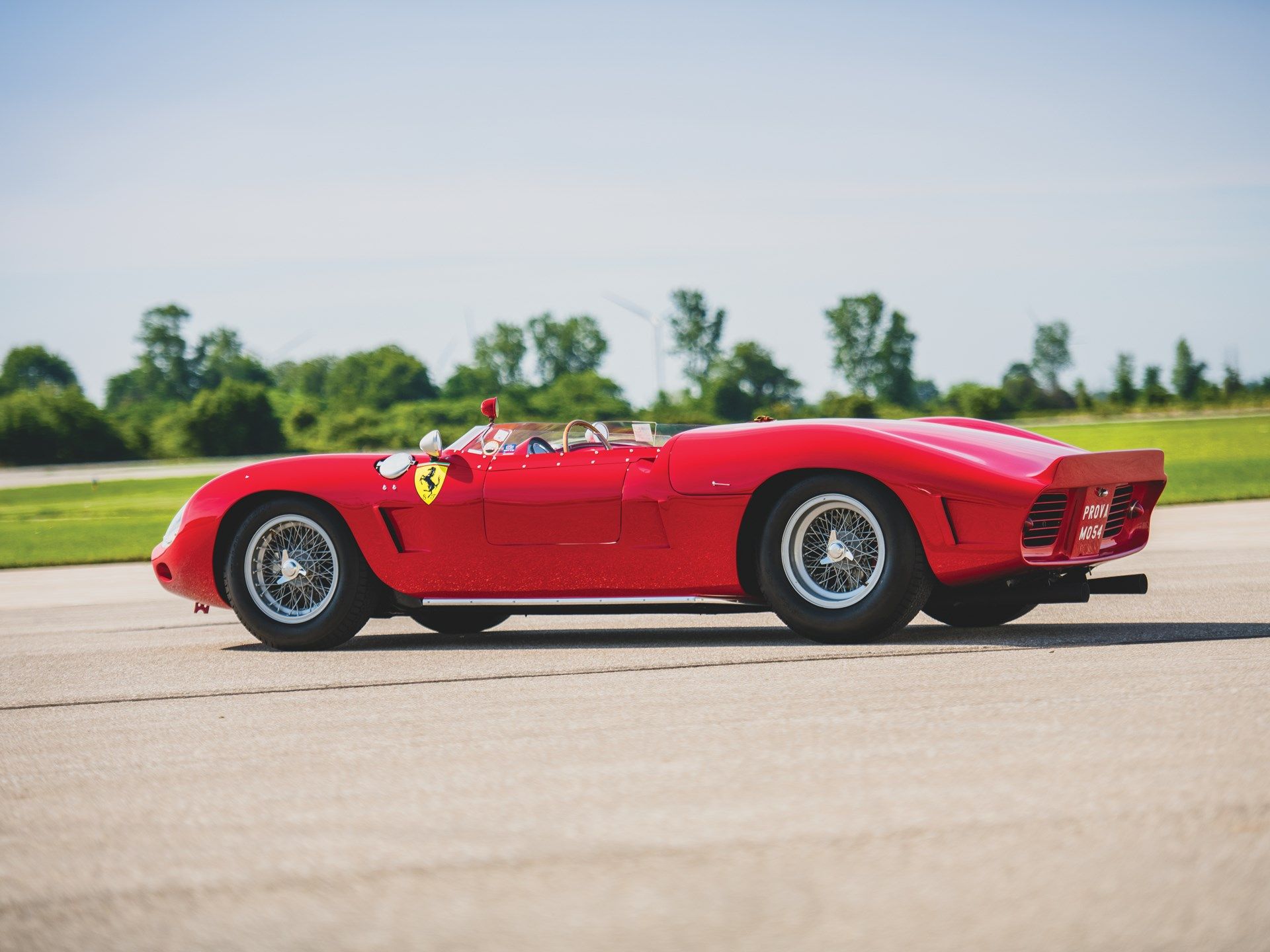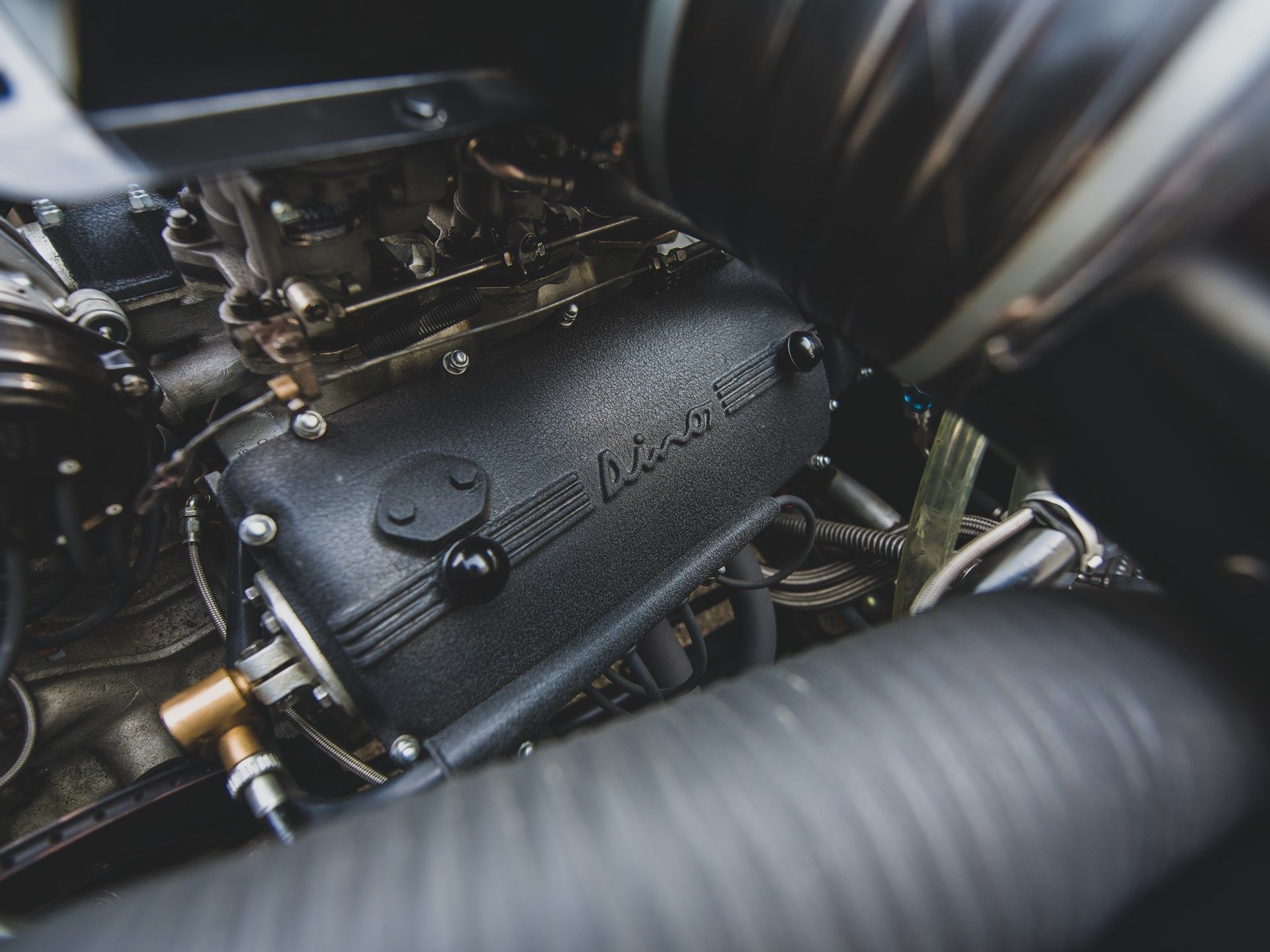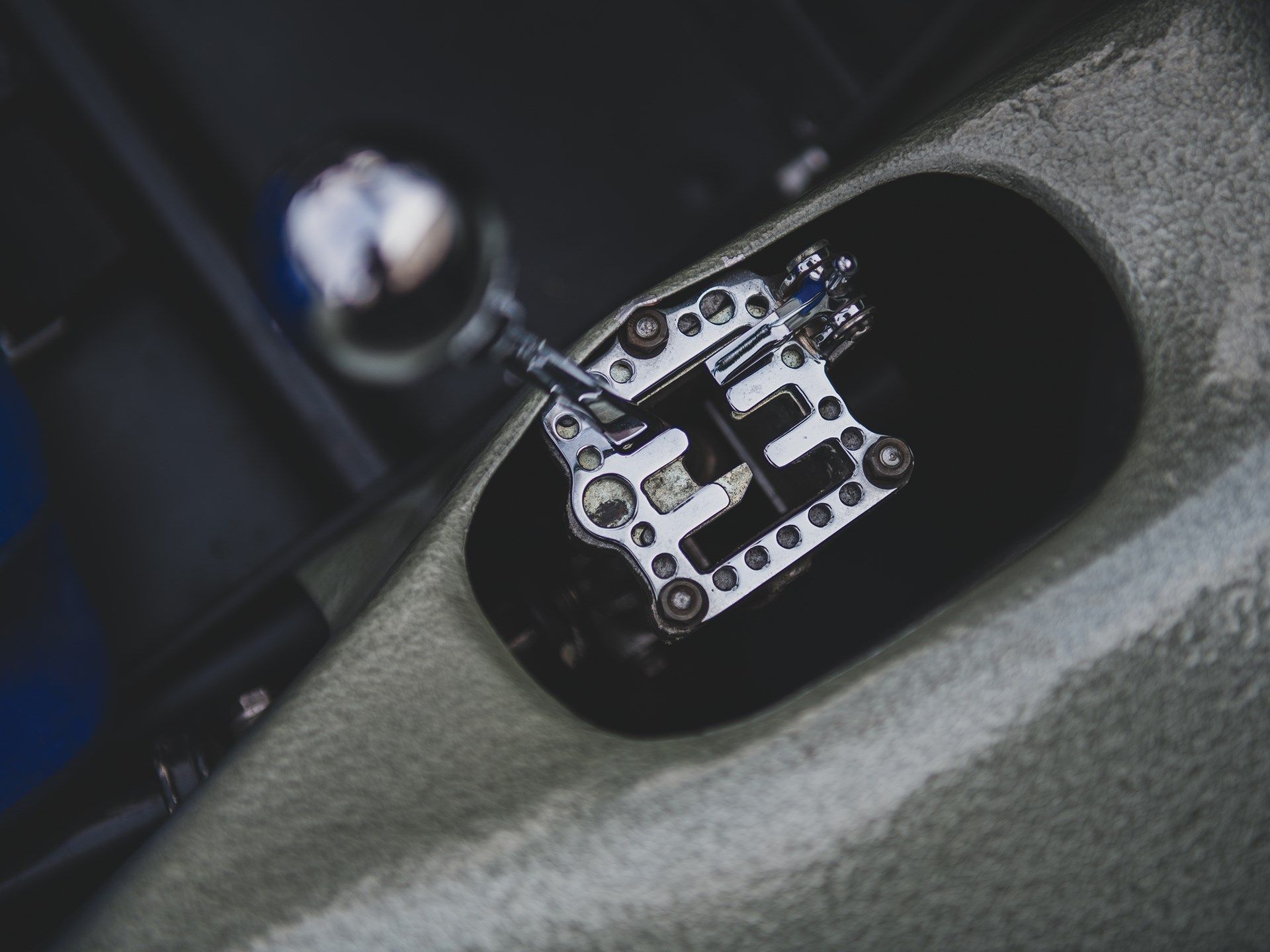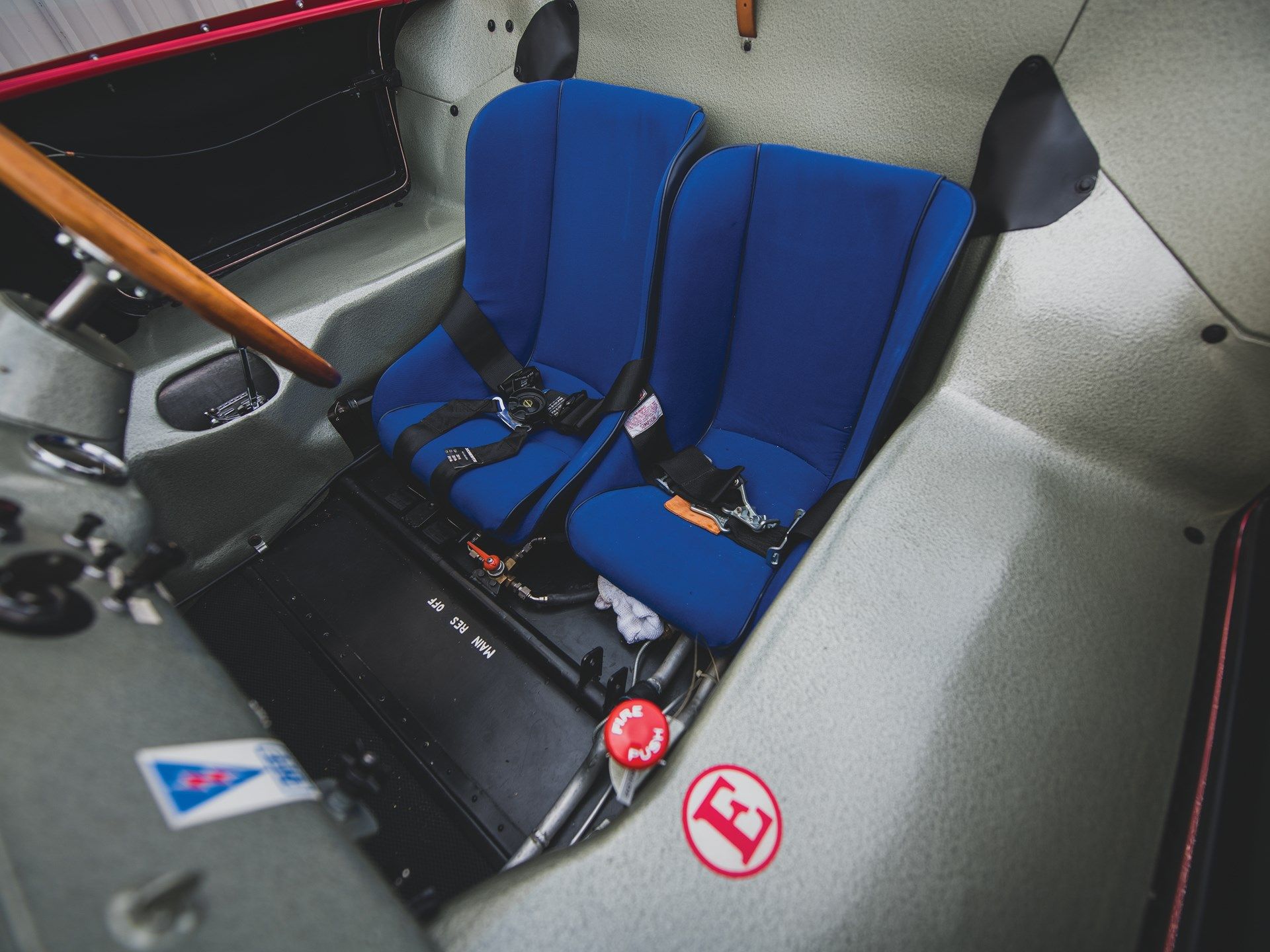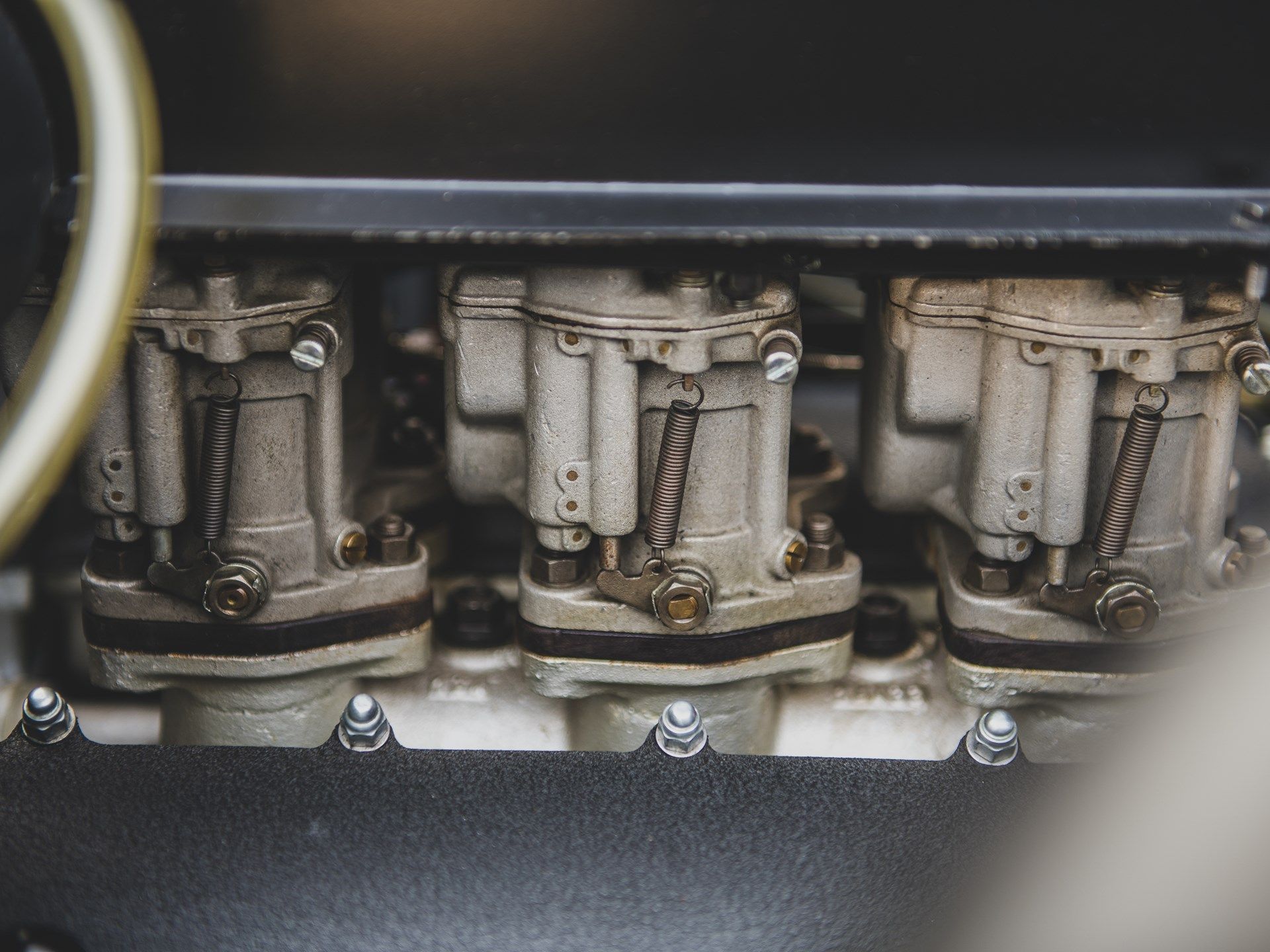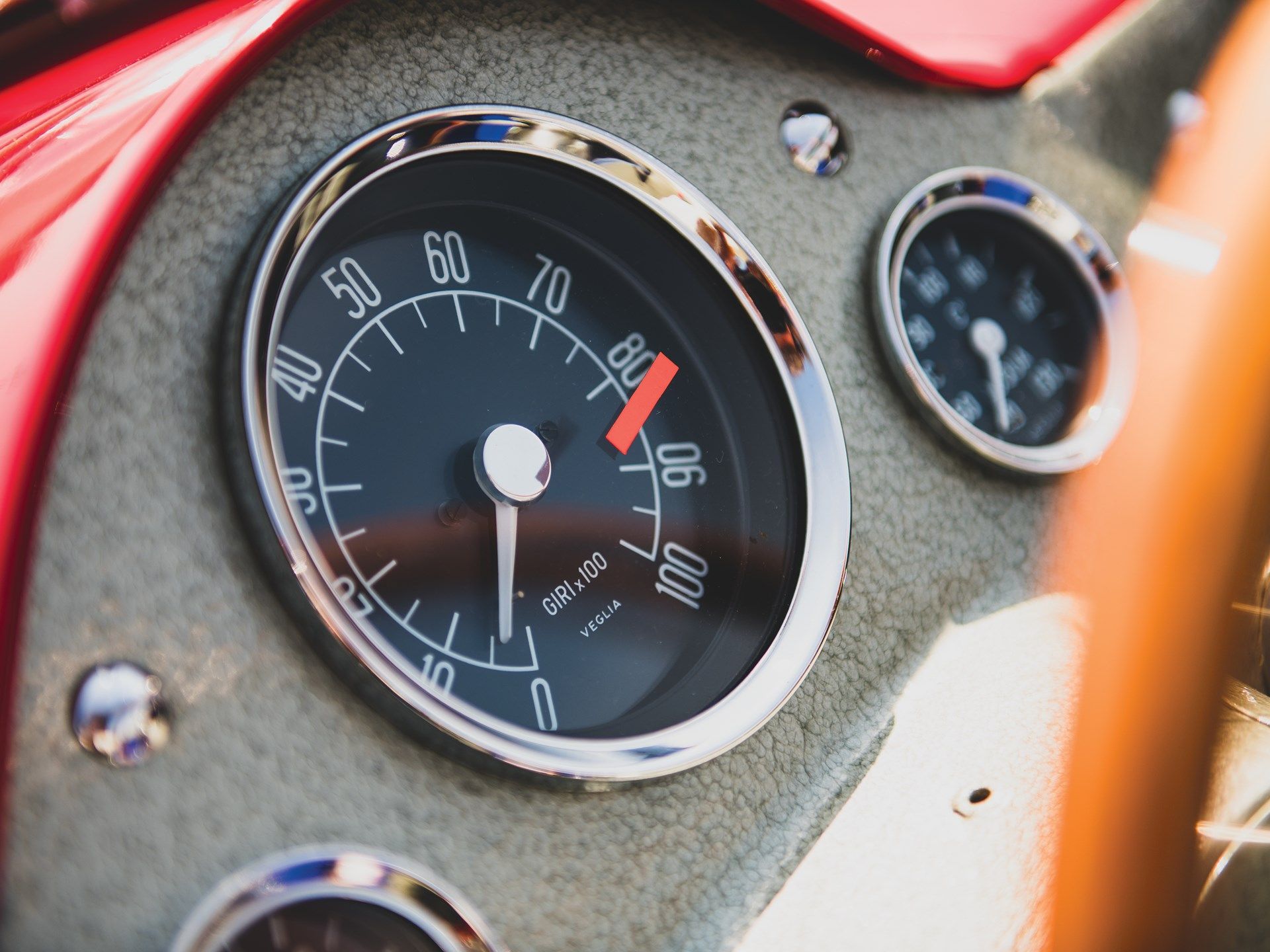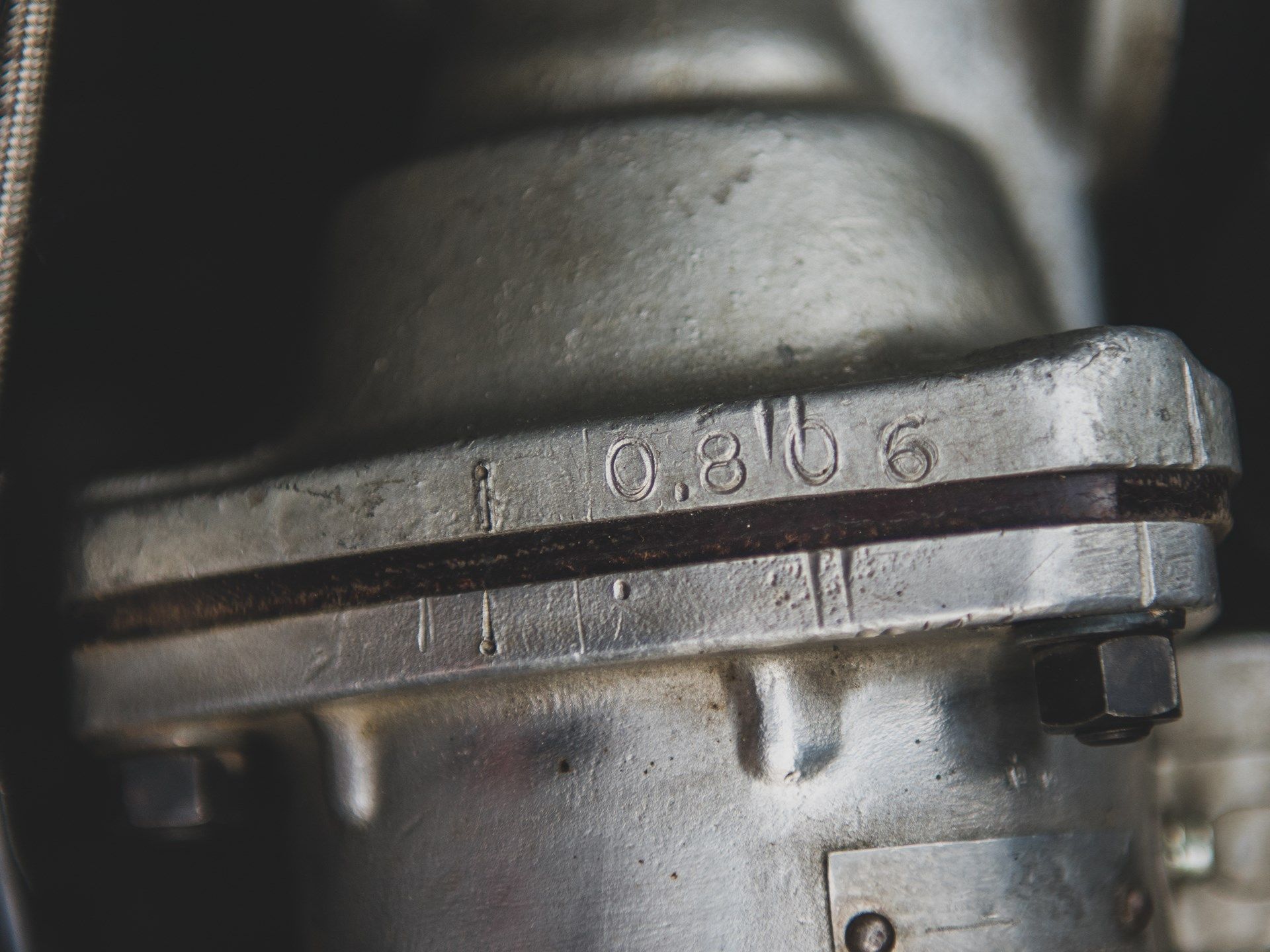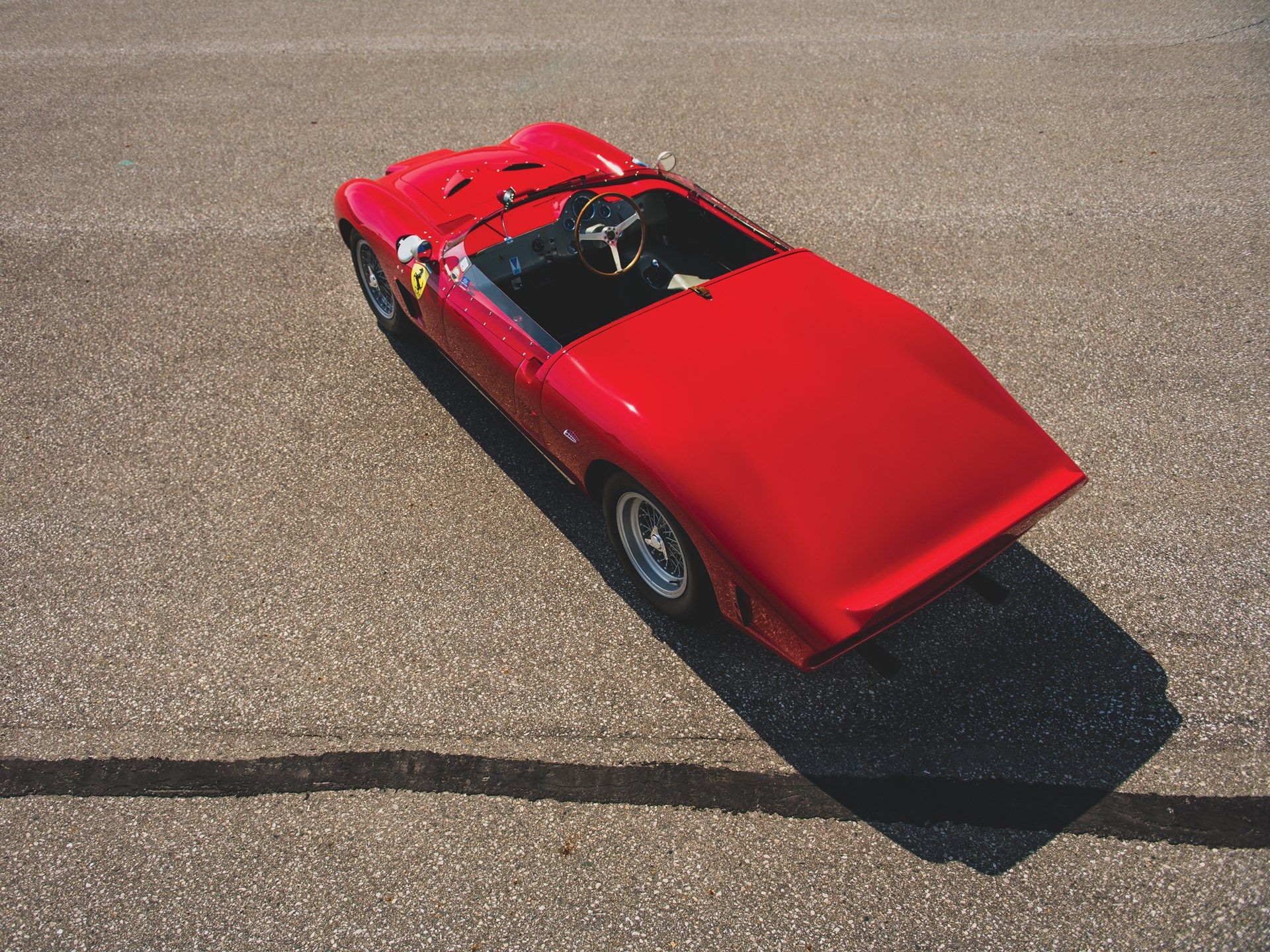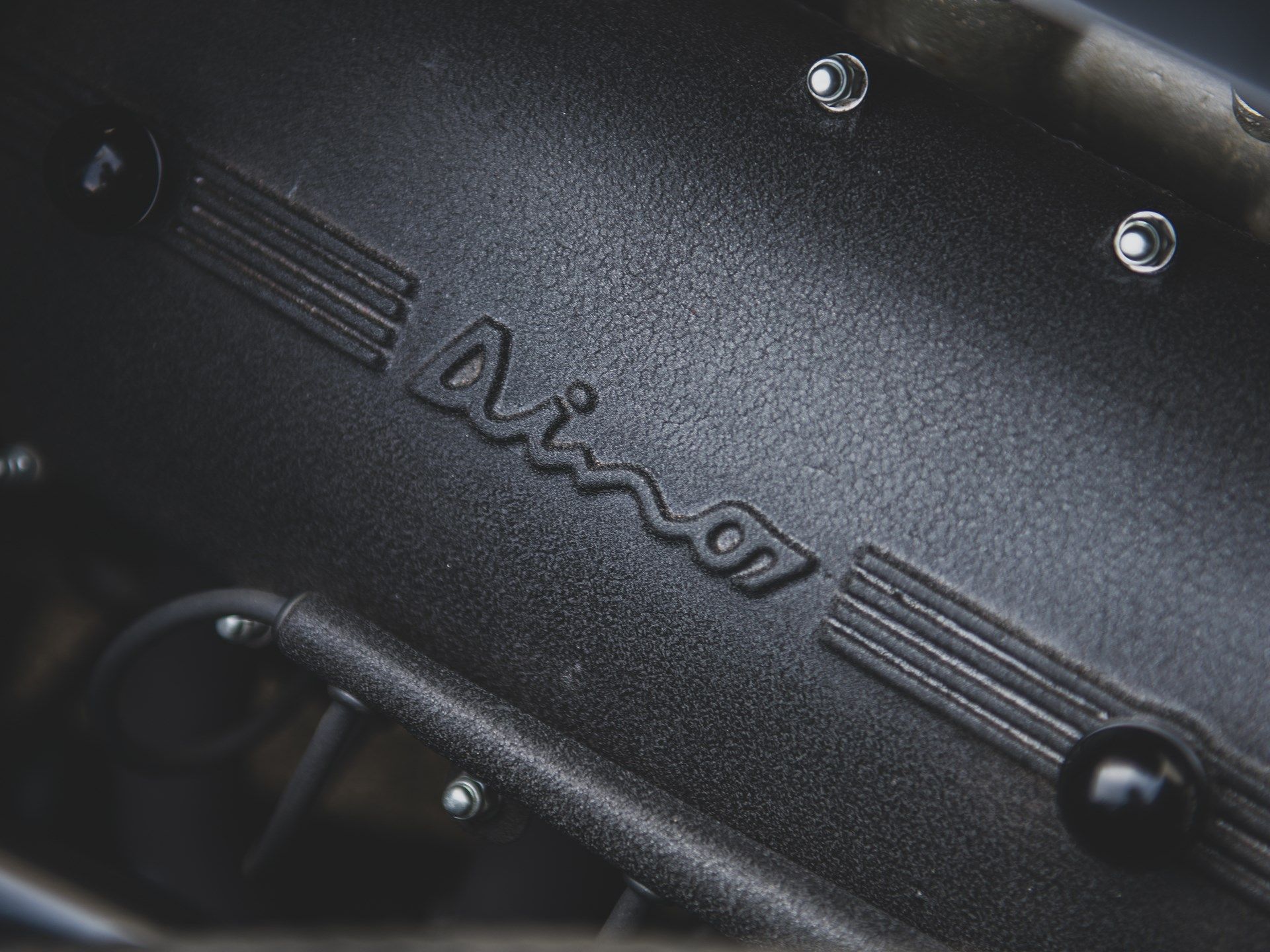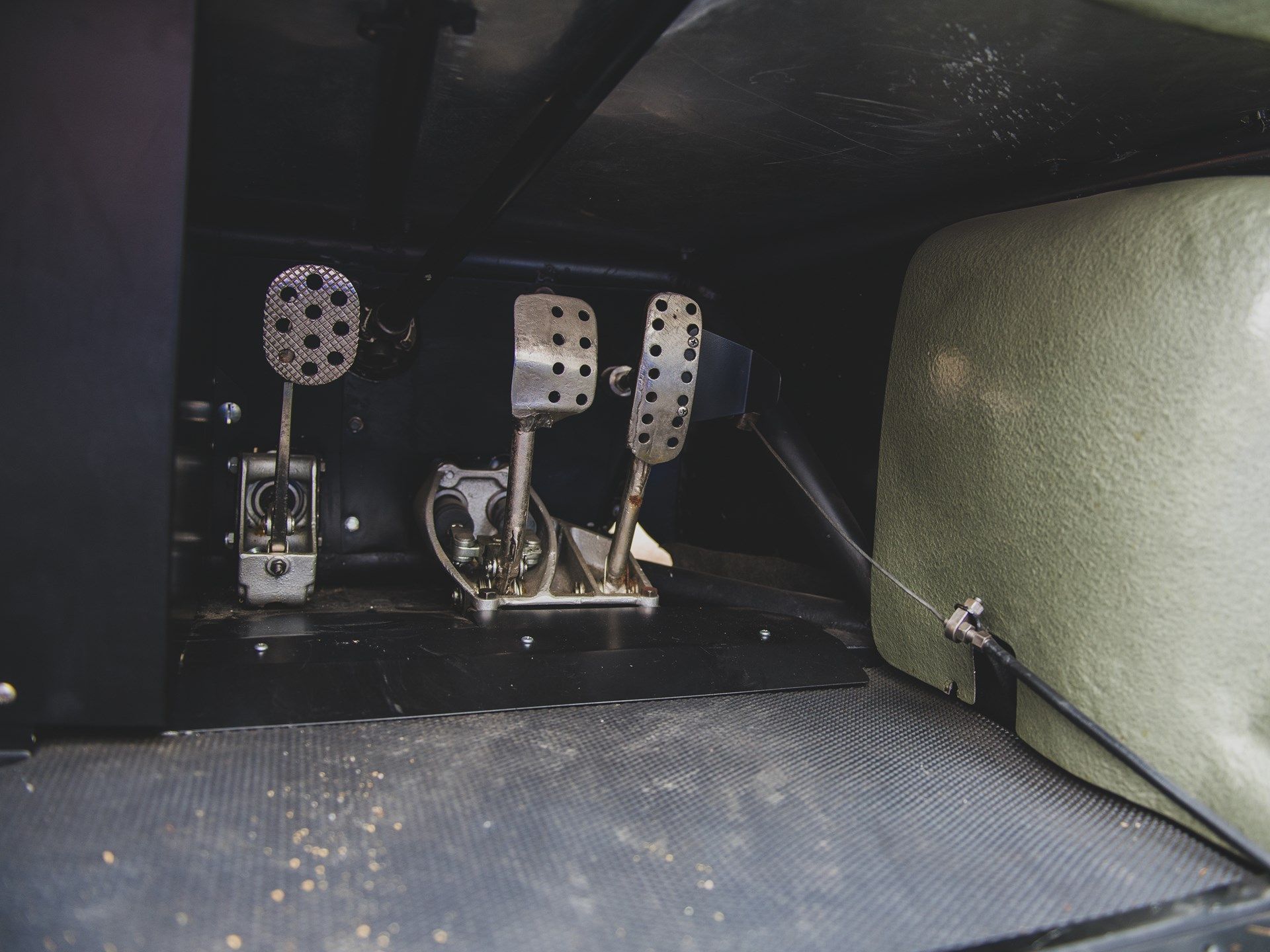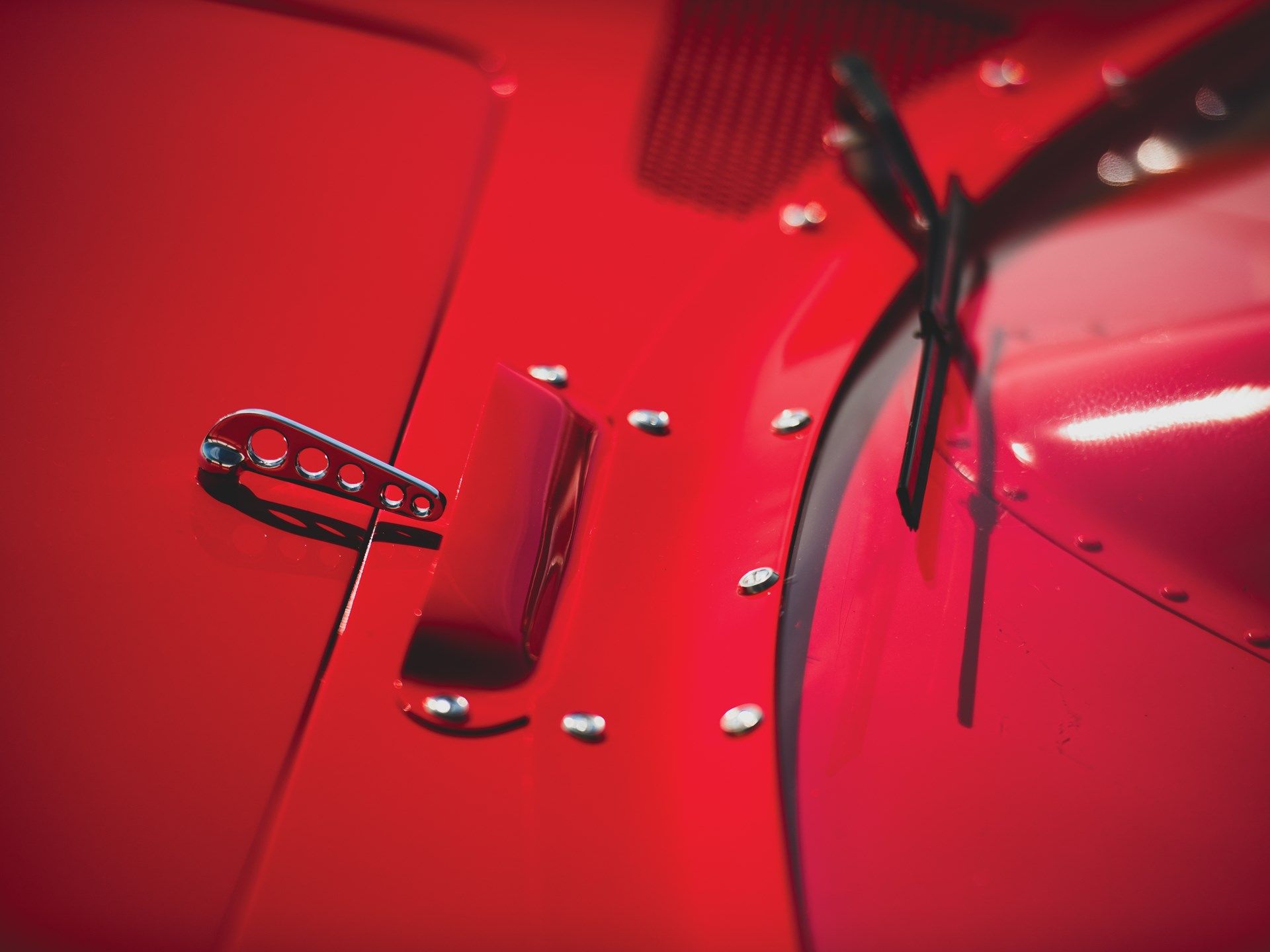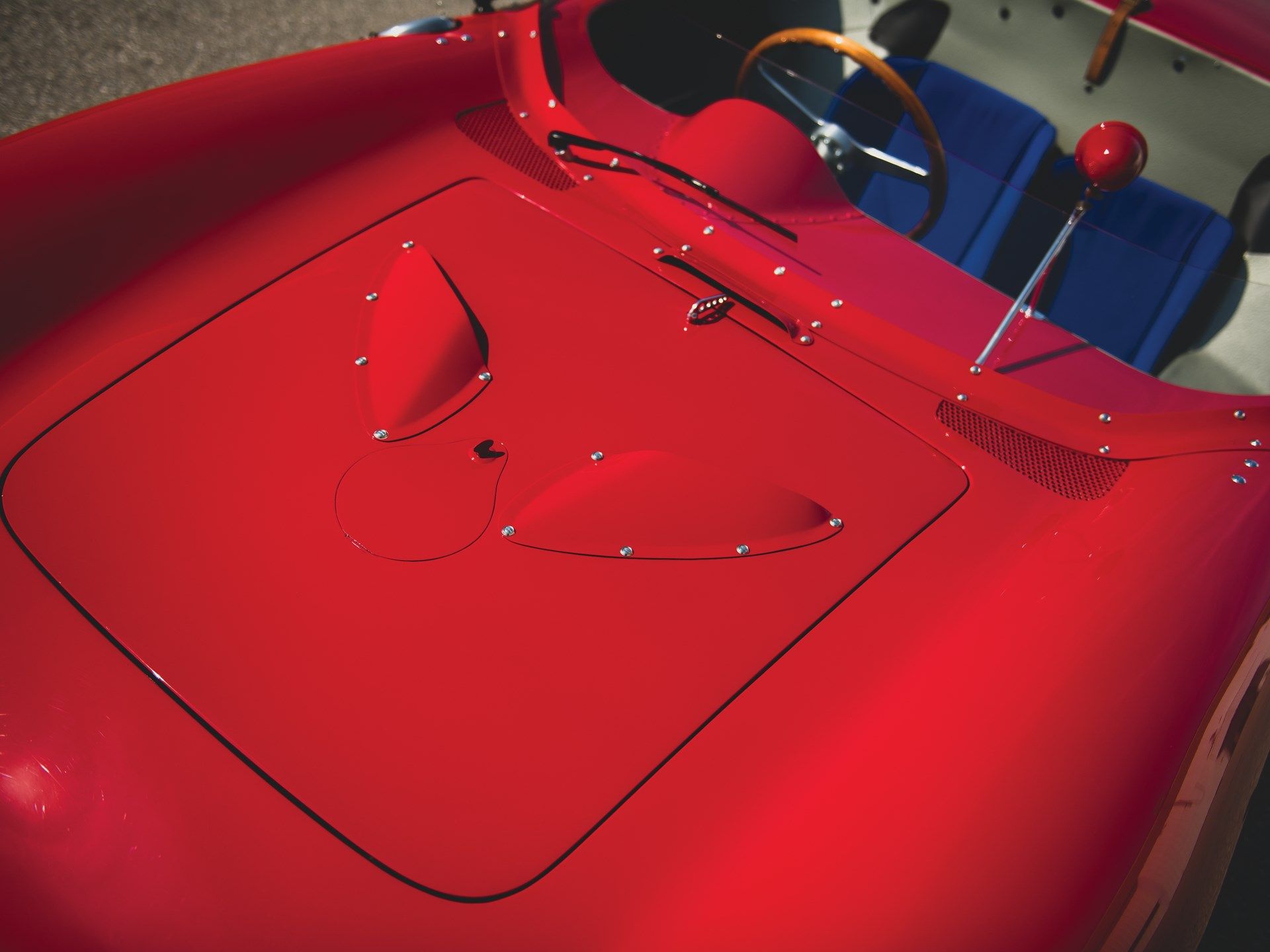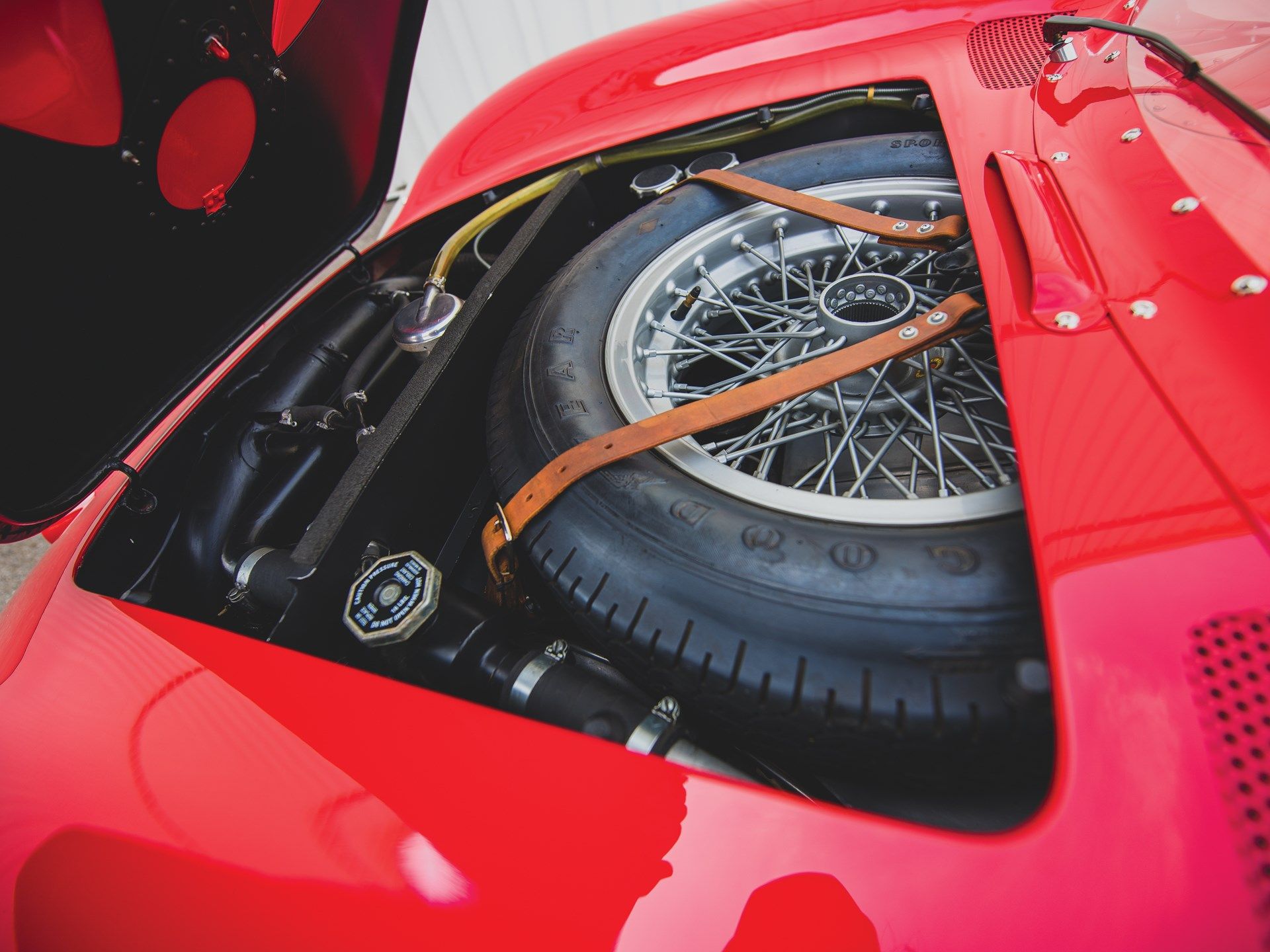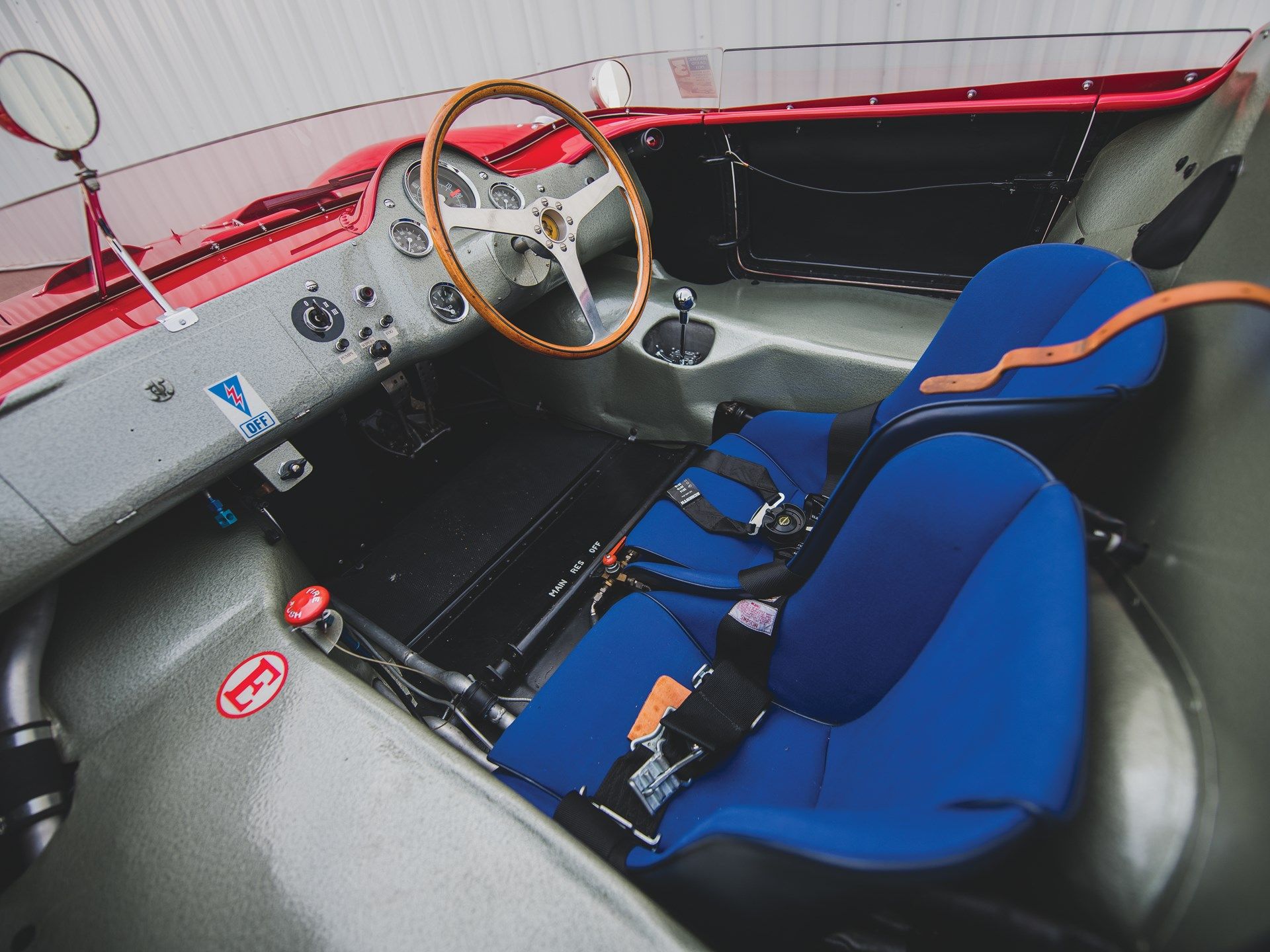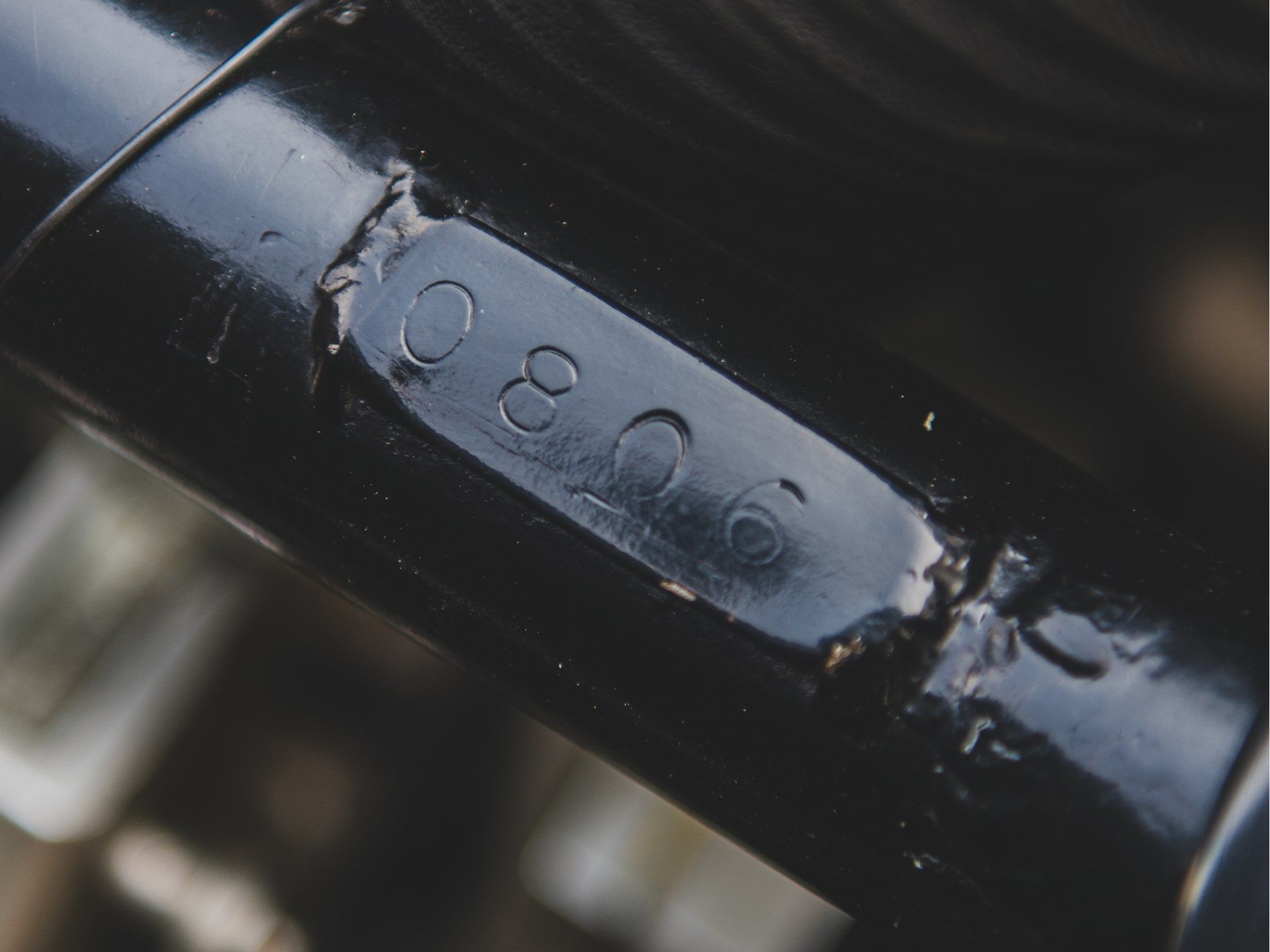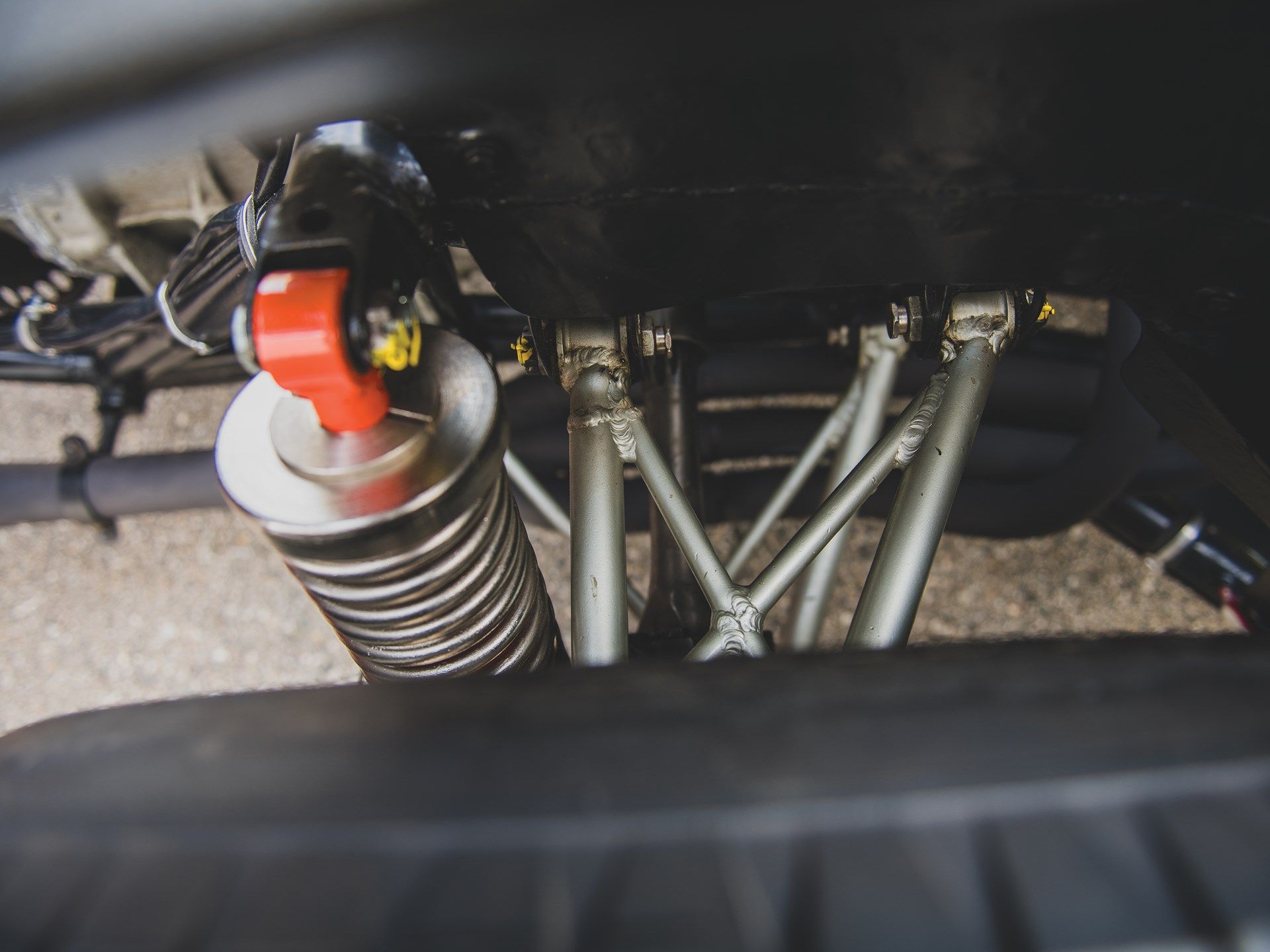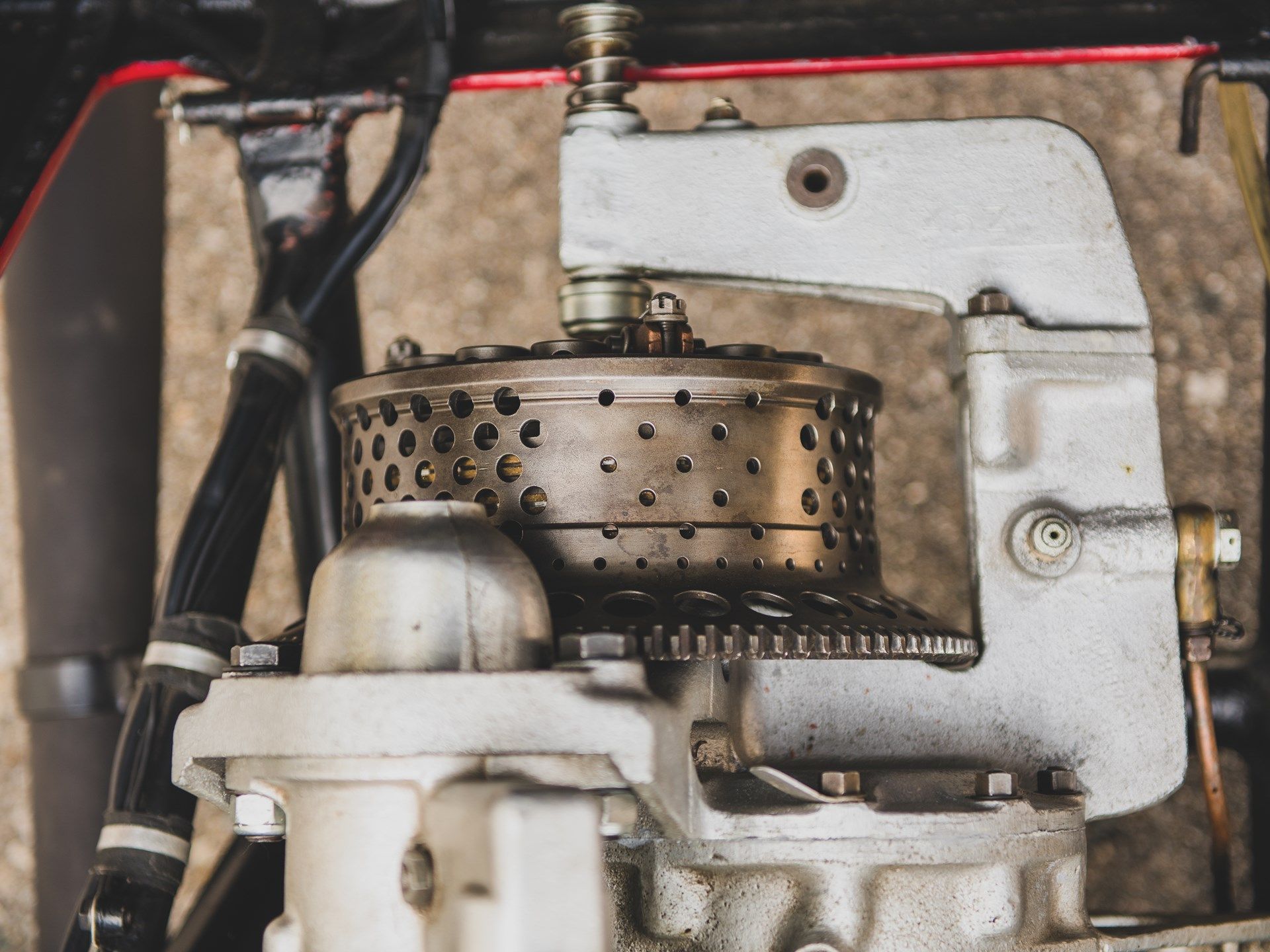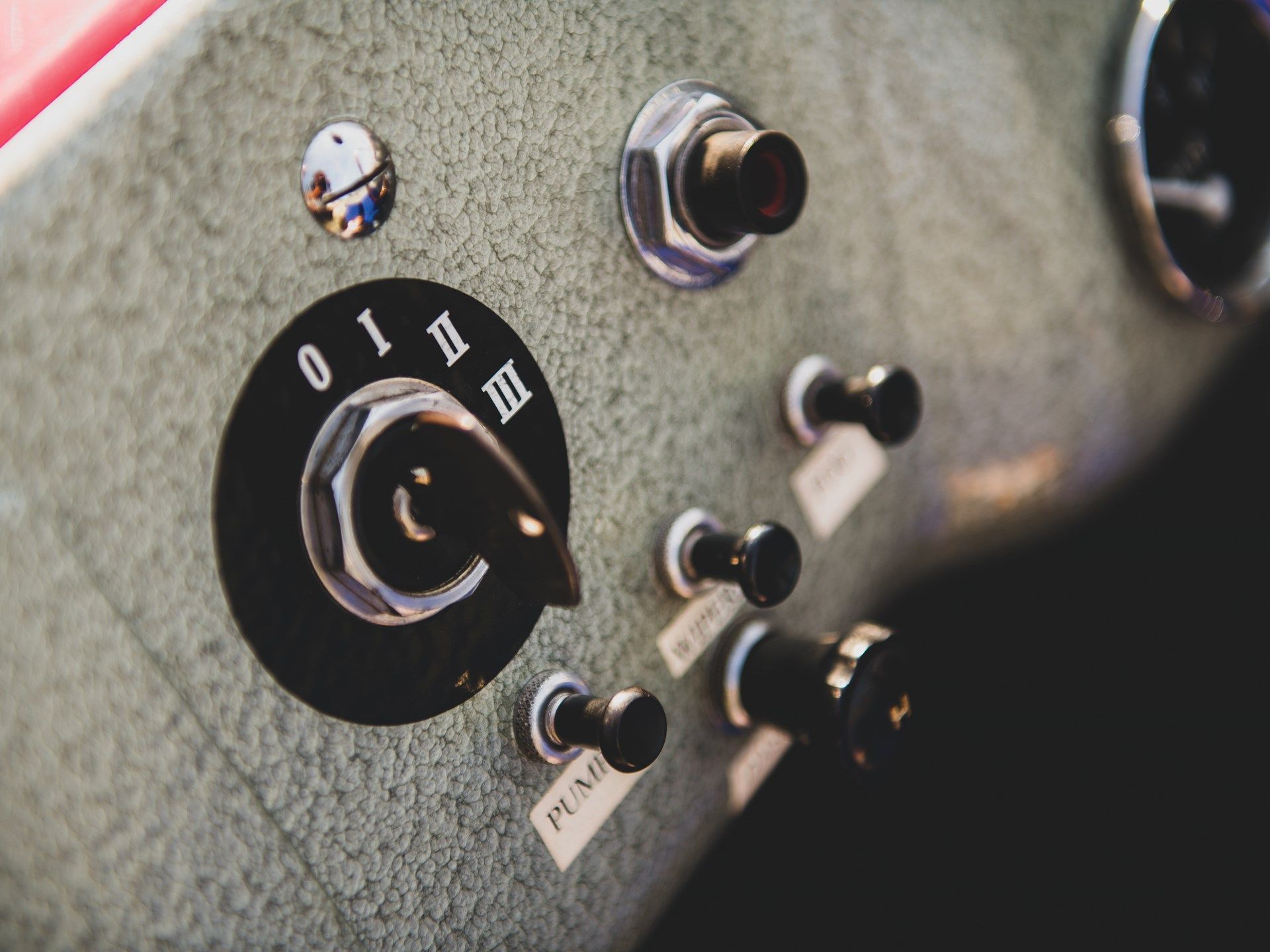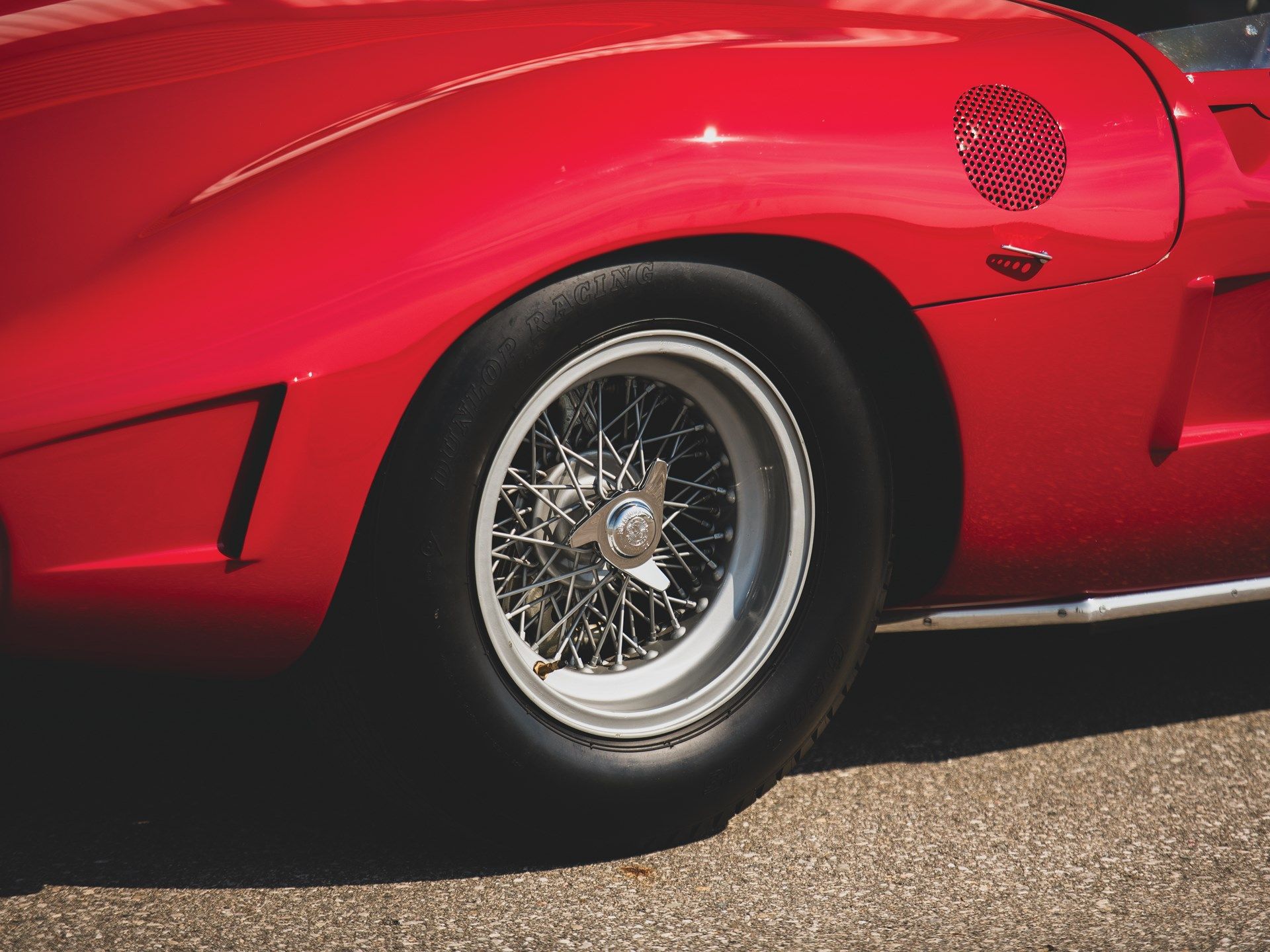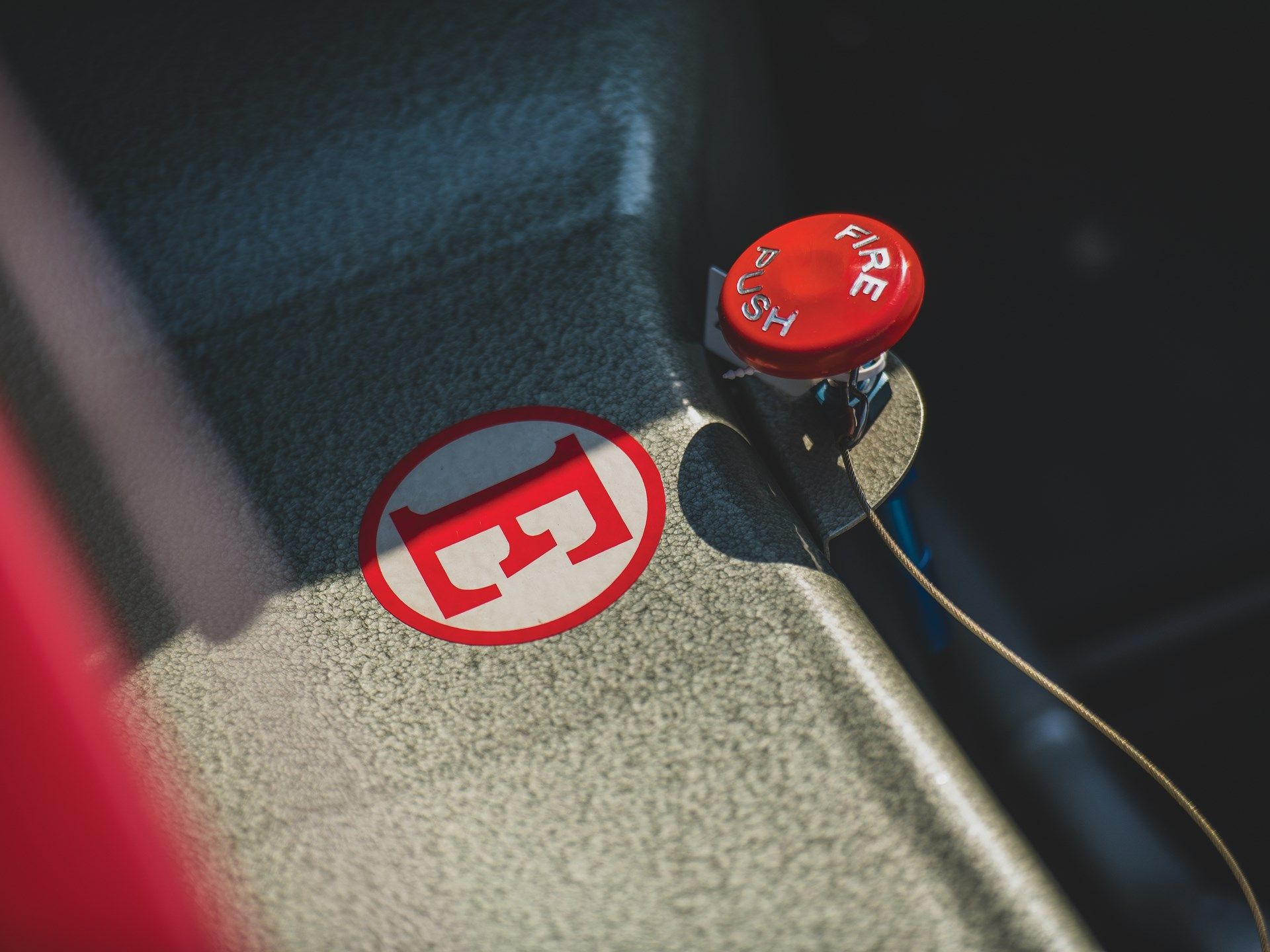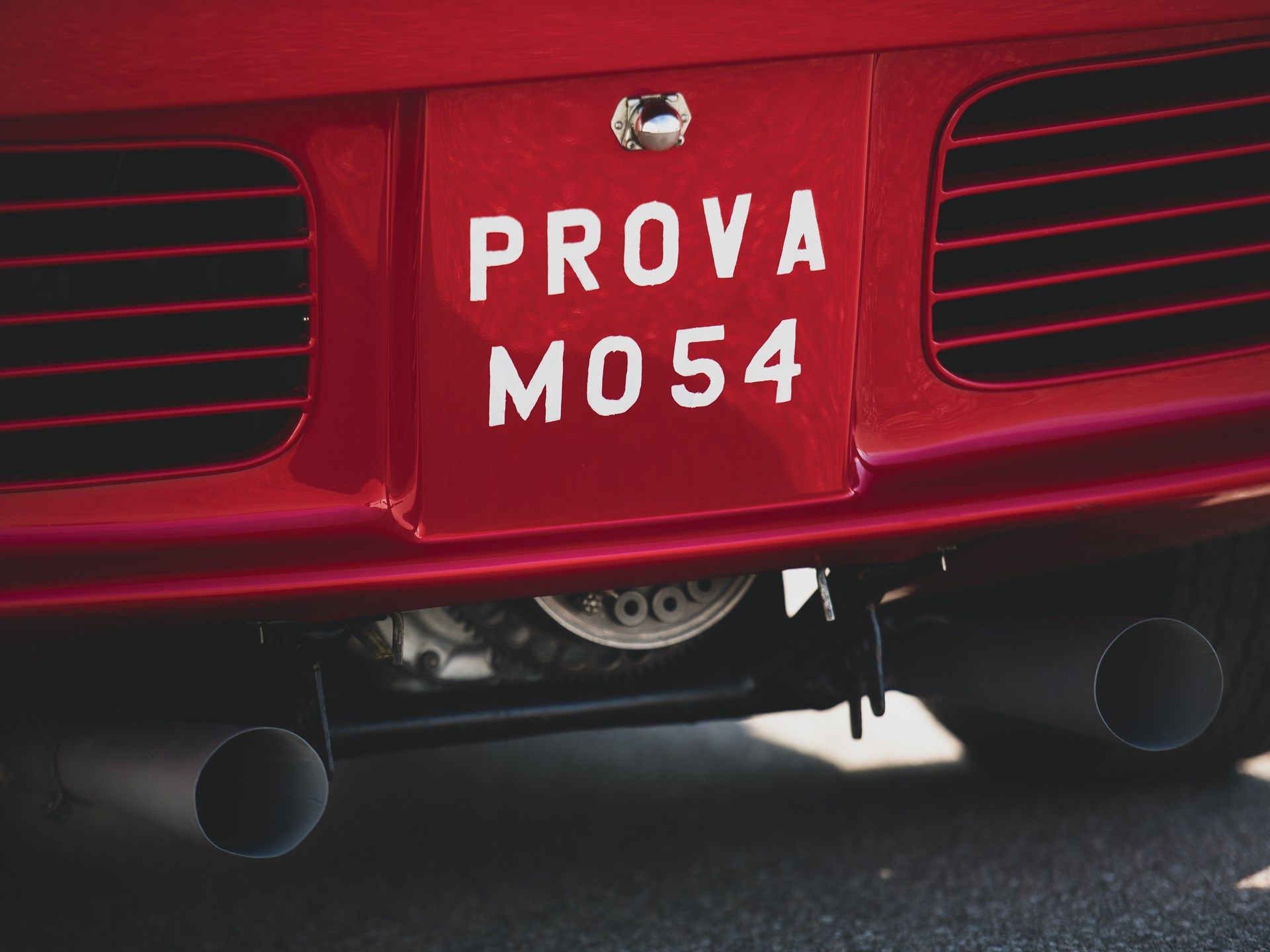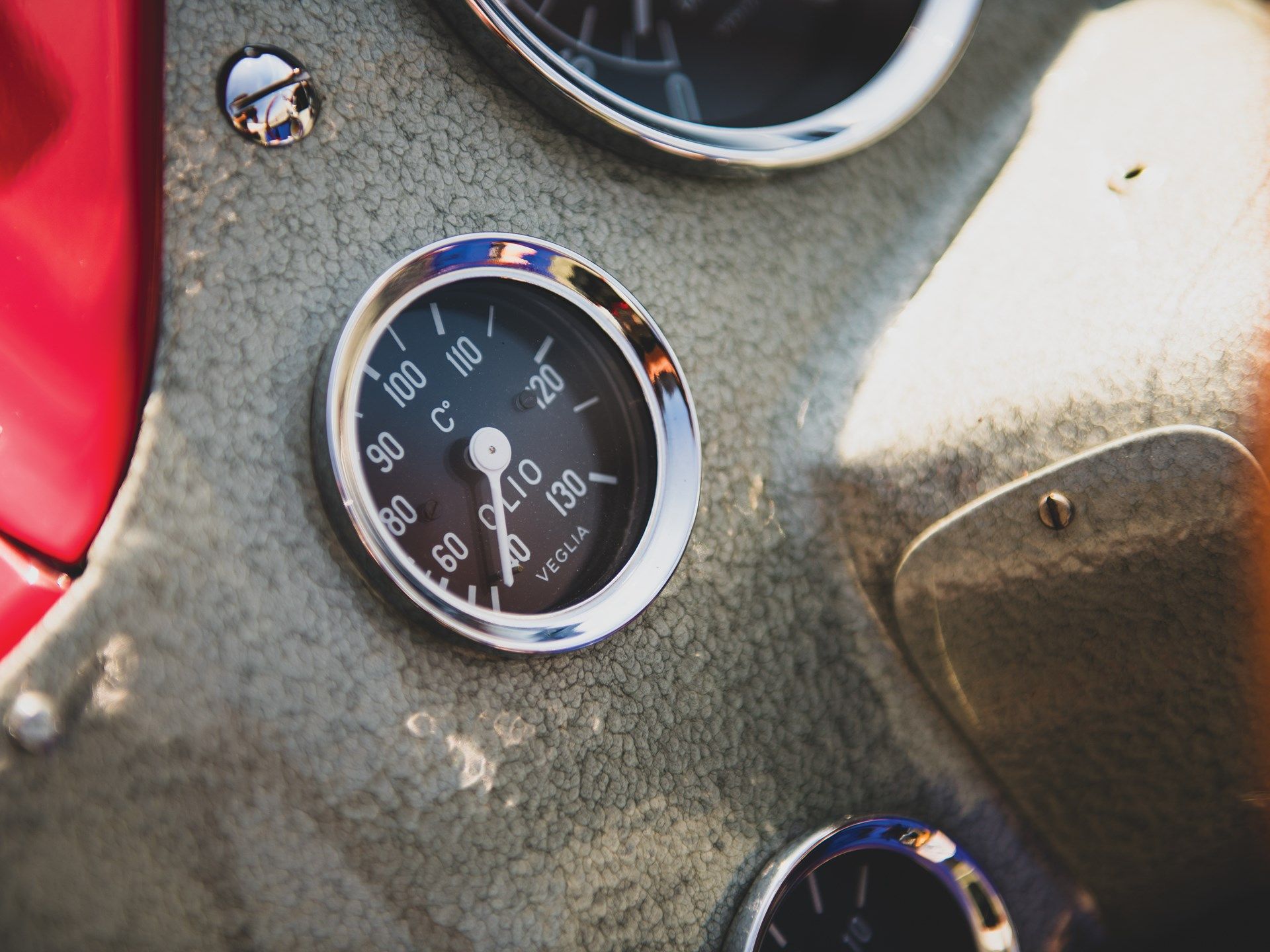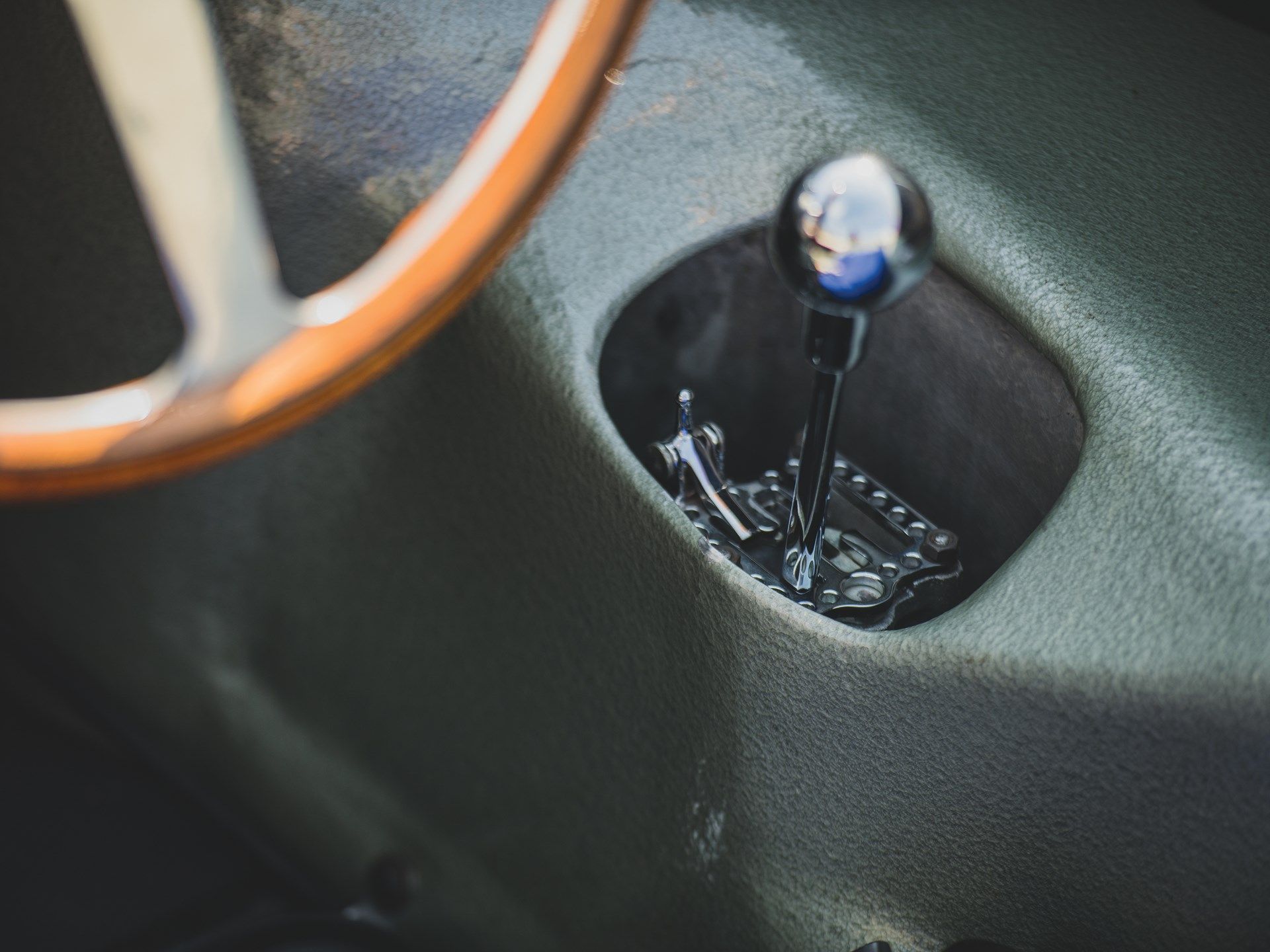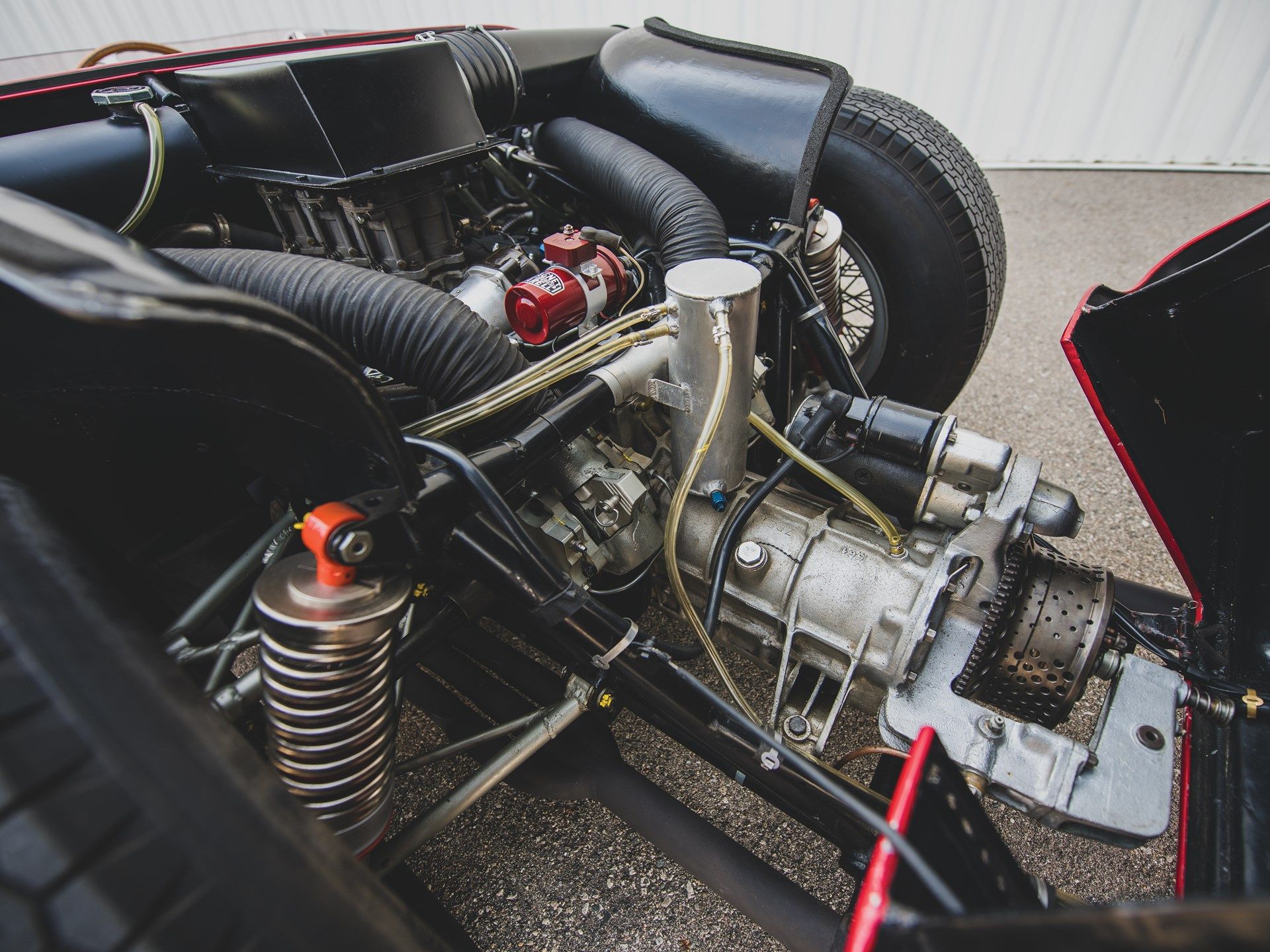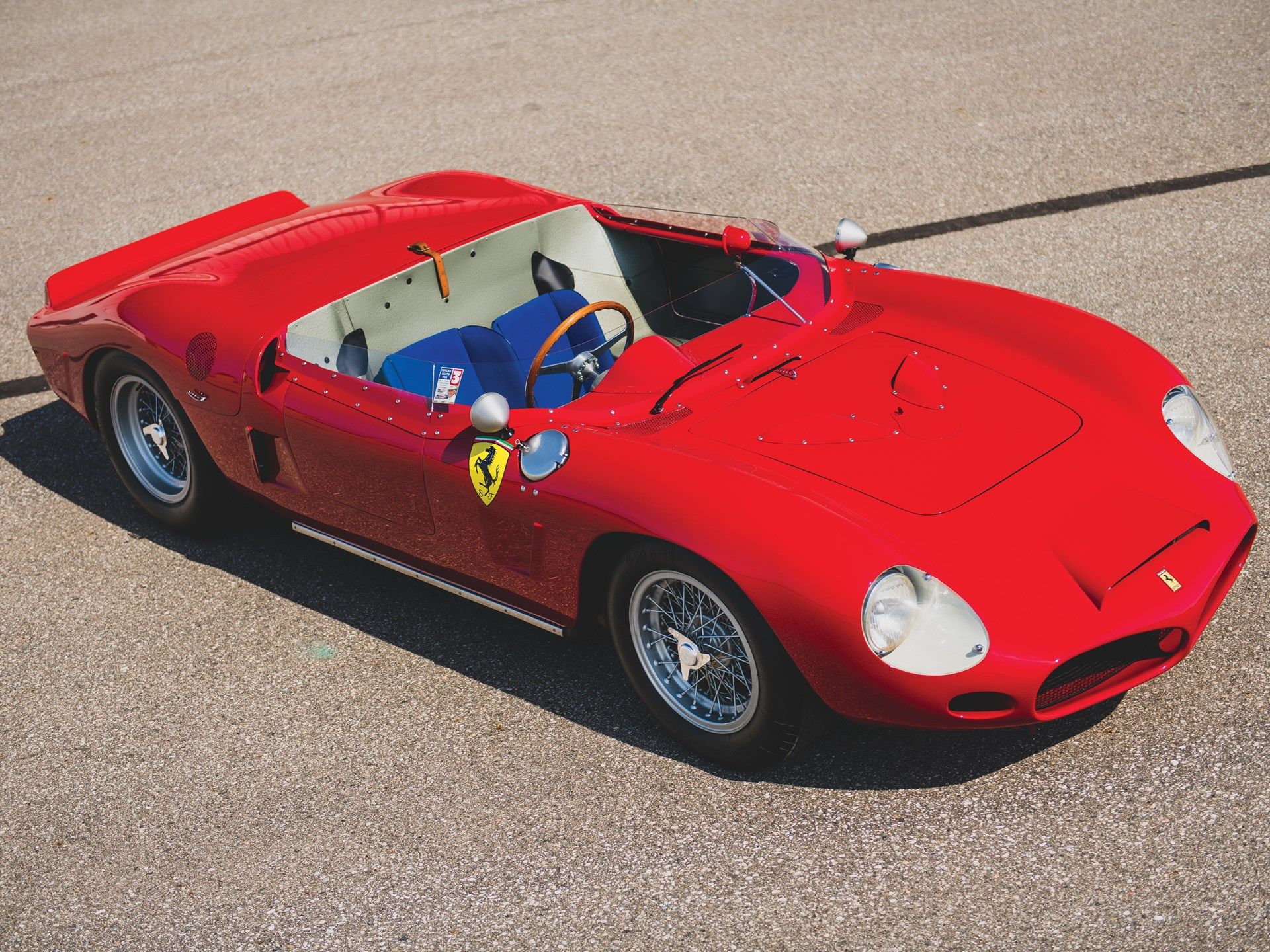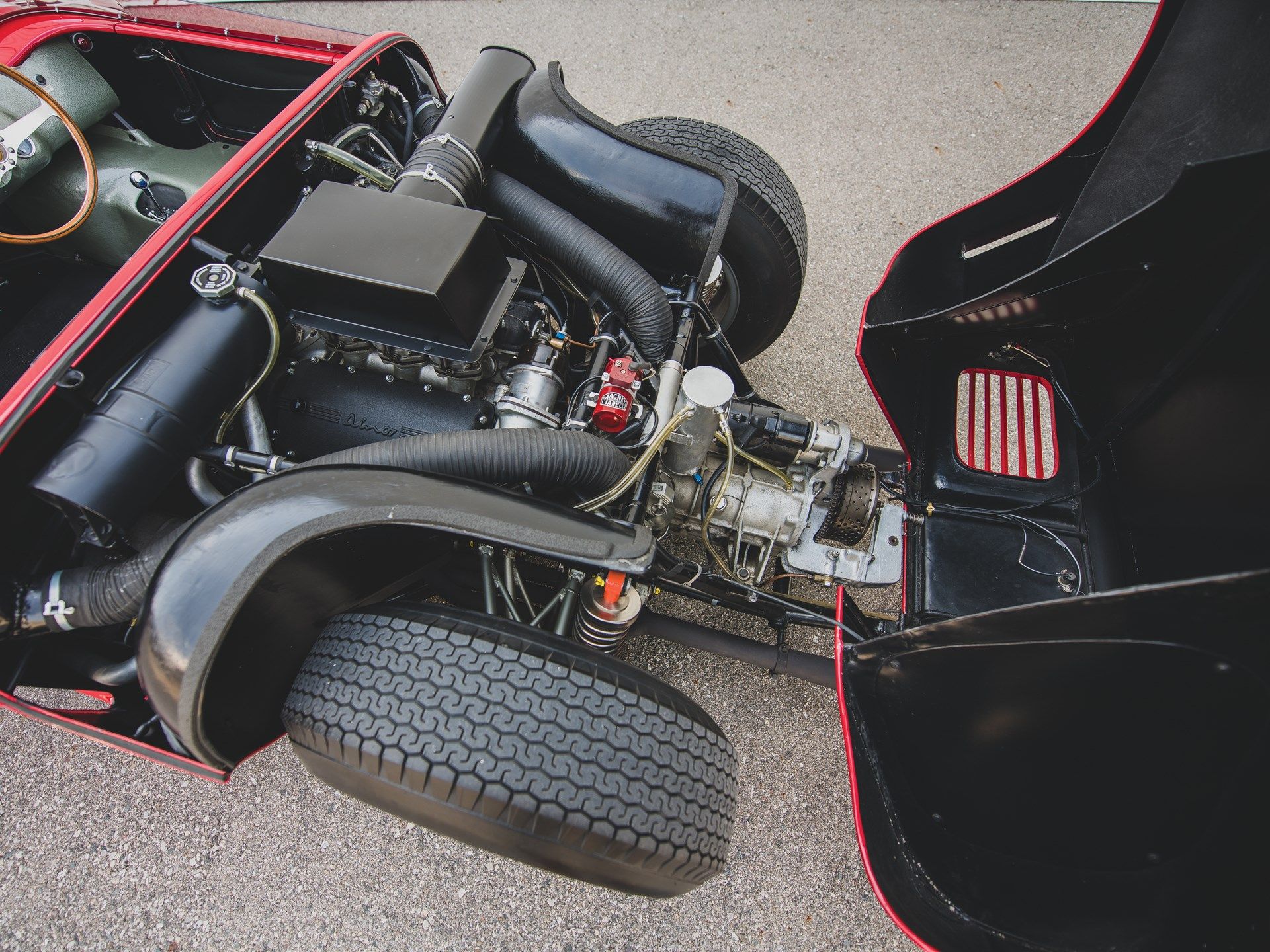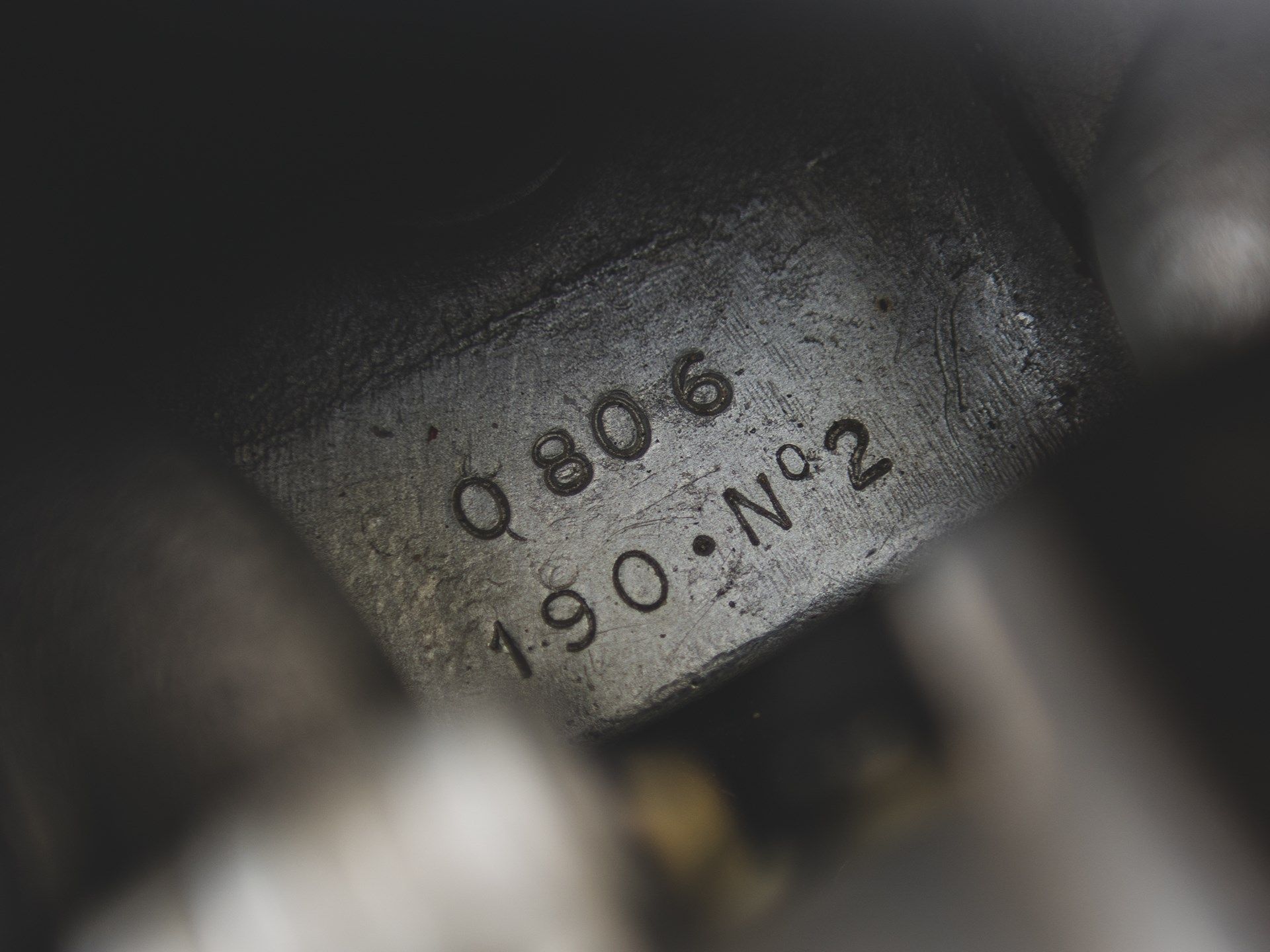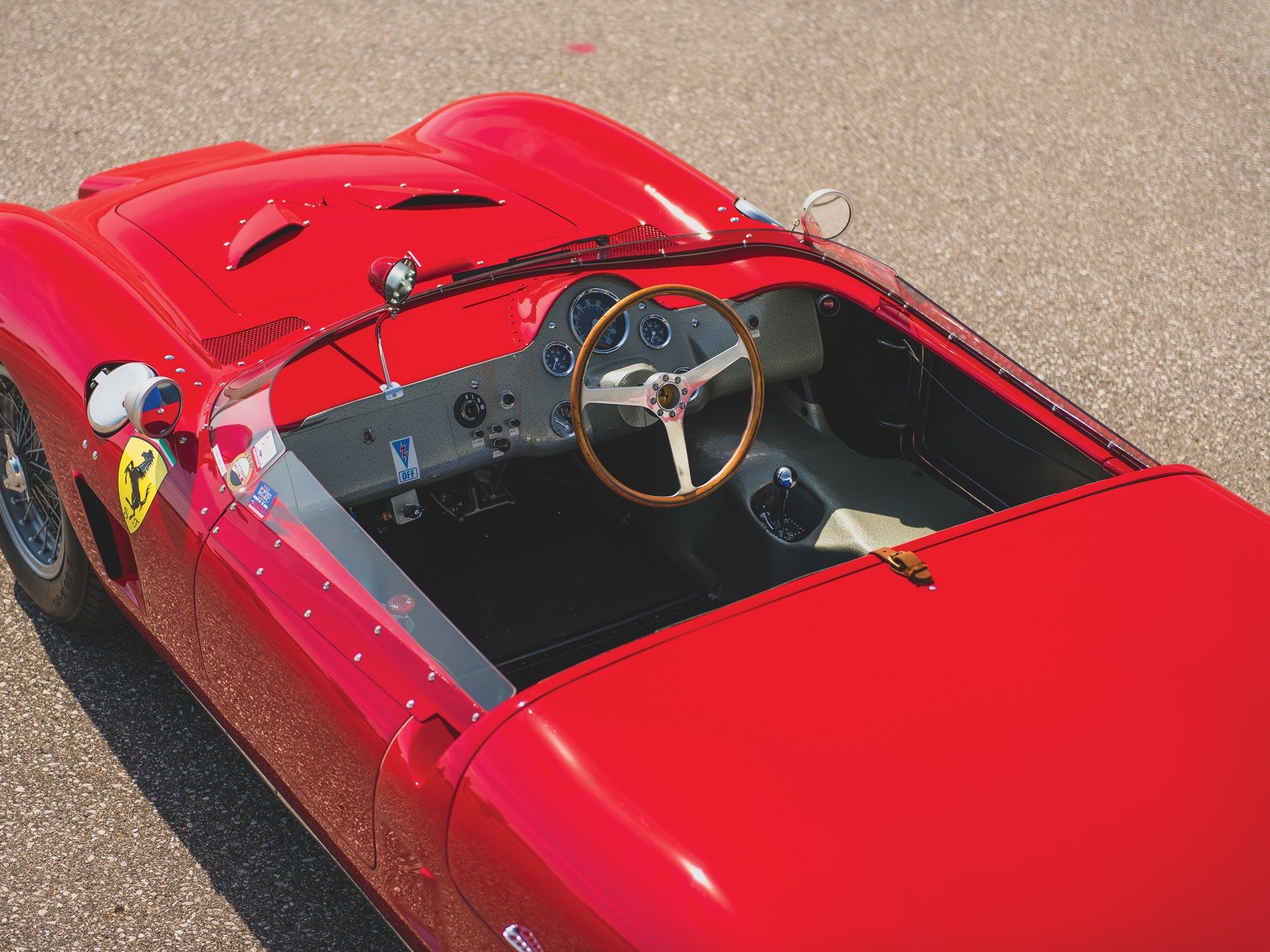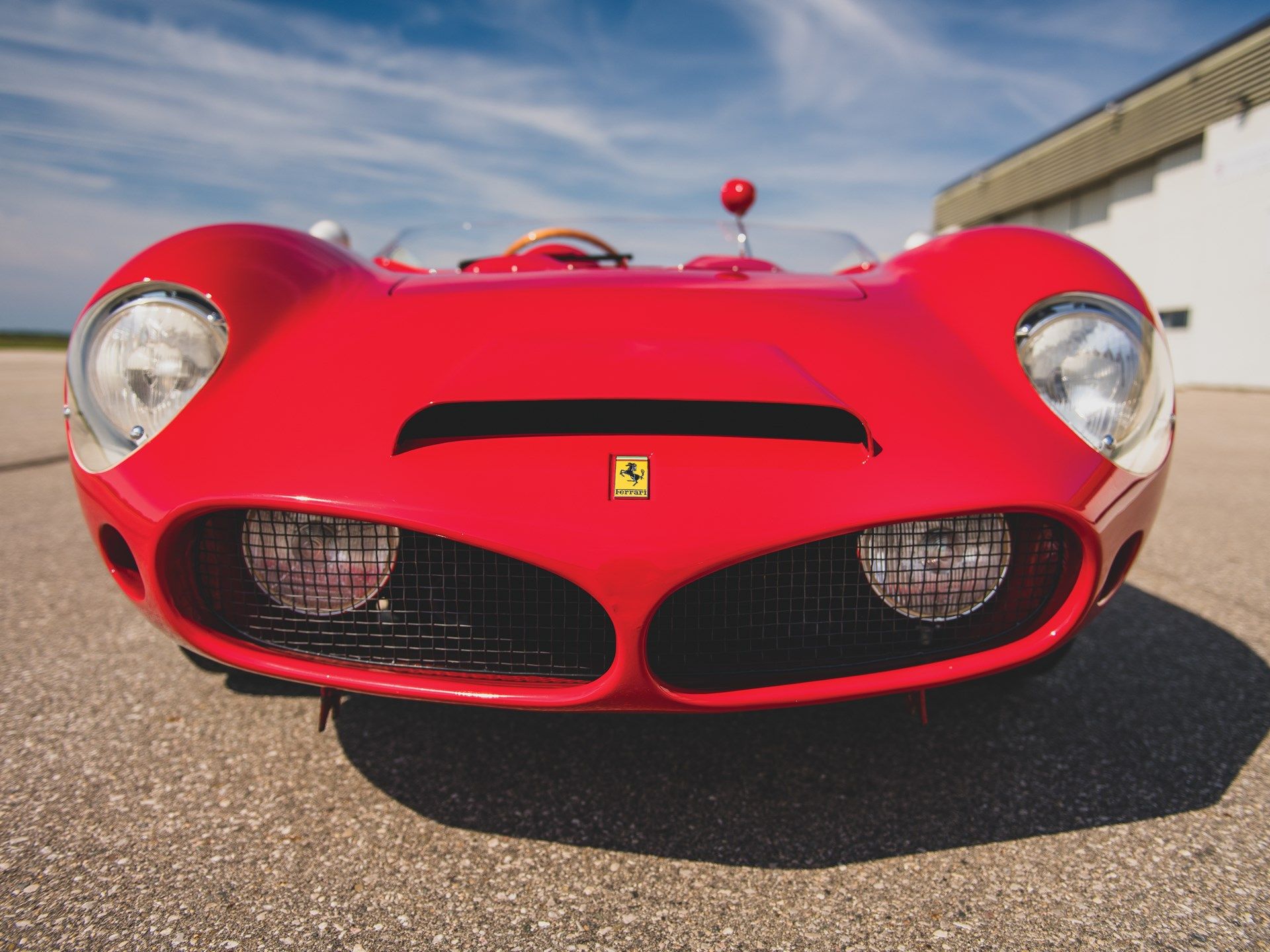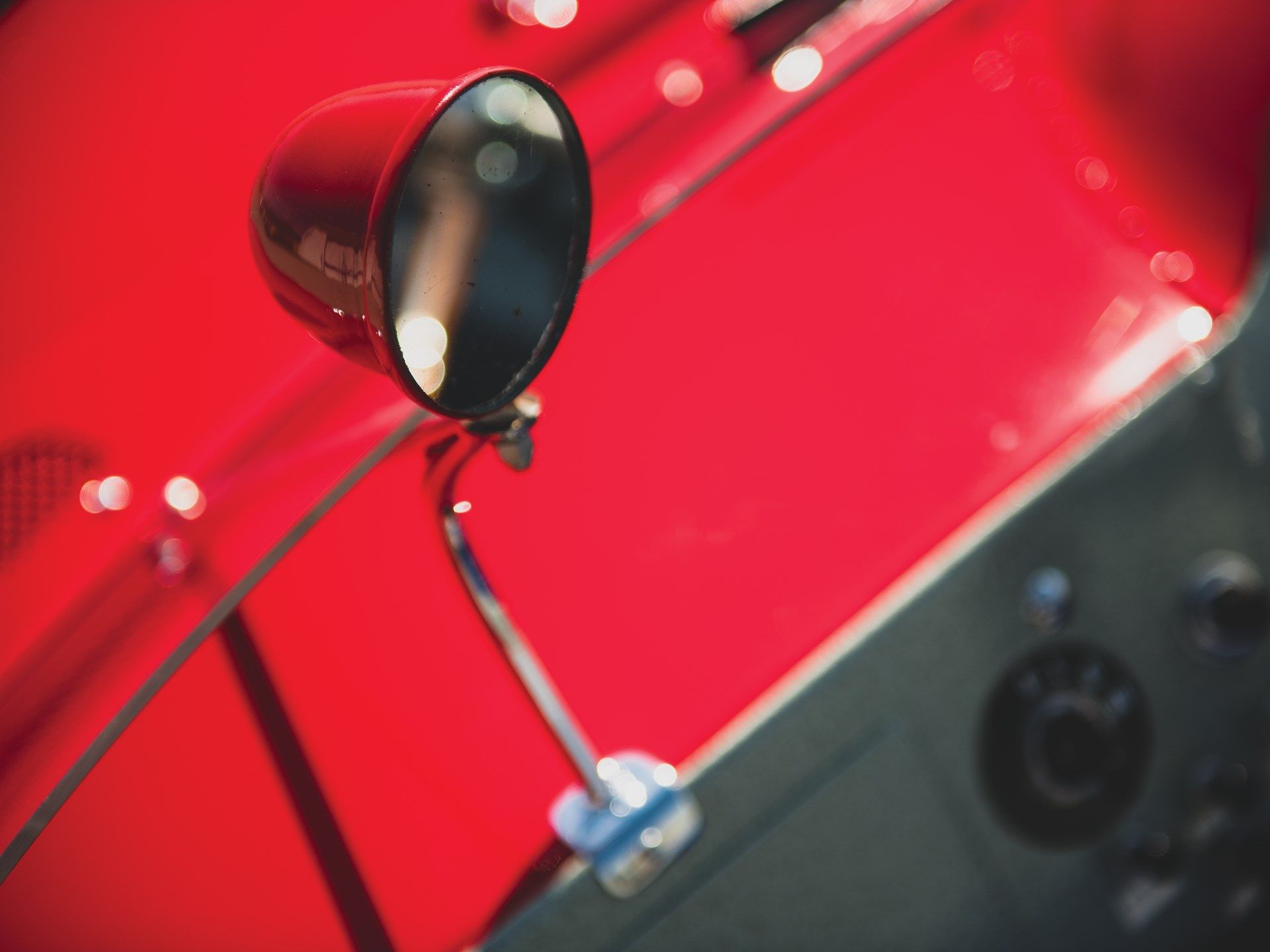The Drake, a man who honed his craft as the team boss of Alfa Corse in the '30s, carried some of the old adages over when he started his own automotive company. It's no wonder, then, that he was reluctant to jump on the rear-mid engine train when it boomed two decades after the last pre-war Grand Prix but when his Prancing Horses finally rolled out with the engine aft of the driver they proved overwhelmingly good: in F1, the 156 steamrolled its way to both the Constructor's and the Driver's F1 title in 1961 and, in long-distance racing, the 196 SP, as a direct descendant of the 246 SP, foresaw what was to come in sports car racing.
The 196 SP is an incredibly rare and incredibly gorgeous beast. With a low-slung body and a nose very similar to that of the 156 F1 car, it carried what was good about the 246 SP, the first Ferrari mid-engined sports car that was unveiled in 1961, and improved on the formula. Under the rear deck, there was, effectively, half of a Colombo V-12, and not the Dino V-6 although the 196 SP has been referred to as the Dino 196 SP in some circles. Five were built for 1962 and this one, chassis #0806 is the only that has survived. RM/Sotheby's tried selling it during the Monterey Car Week but failed. Still, the car is valued at anywhere between $8 million and $10 million. Keep reading to find out why this V-6-engined Ferrari is worth more than twice the price of a LaFerrari, Maranello's V-12 hybrid wonder.
1962 Ferrari 196 SP by Fantuzzi
- Make: Array
- Model: 1962 Ferrari 196 SP by Fantuzzi
- Engine/Motor: V6
- Horsepower: 210 @ 7500
- [do not use] Vehicle Model: Array
1962 Ferrari 196 SP by Fantuzzi Exterior
The '60s was a decade of rapid evolution in the world of motorsports. If mid engines and aerodynamics were seen as black magic in 1959, by 1969 both were commonplace with teams experiencing with a variety of wings - some high and some low, the latter prevailing in the end - and other aerodynamic appendages while front-engined cars were relegated to the GT ranks.
The change happened quickly and, while some avid supporters of the old way of doing things tried to resist it, there was no going back and the rear mid-engine layout won over everybody eventually. Of course, there were always going to be oddballs (read Dr. Don Panoz among others) but, for the most part, the time for the front-mounted engine at the sharp end of sports car racing was over.
Ferrari was one of those adamant supporters of the front-engine layout, even as his 246 F1 cars got beaten by the lithe and nimble Coopers in 1958 at the Monaco GP. Of course, that year the 246 with its 2.5-liter Dino V-6 powered Hawthorn to his first and only F1 Driver's Title so Enzo had nothing to worry about - or so he thought. The following year, Coopers were dominant and Jack Brabham became champion. In the light of all this, pressure from within Ferrari to switch to a mid-engine layout forced Enzo to take a decision. Both Vittorio Jano, the Chief Designer at the time, and Carlo Chiti, Head of the Engineering department, saw this as the only way to keep Ferrari at the forefront and Enzo finally agreed.
However, this didn't translate into an immediate change in fortunes for Ferrari as things moved slowly.
Back in Italy, the Scuderia used this chassis, #0008, as a mule for the 1961 rules that stipulated a change in engine capacity from 2.5-liters down to 1.5-liters (up until 1960, F2 cars ran 1.5-liter engines so, in effect, 1961-spec F1 cars were in some ways on par with previous year's F2 cars). That meant Ferrari was prepared for the new rules and the 156 F1 car with its 1.5-liter V-6 tested on the 246P (that became the 156P when the 1.5-liter was installed) was dominant all throughout 1961 thanks to its power advantage over Cooper and Lotus.
In 1962, Ferrari continued down this path and introduced an updated version of the 246SP that could be fitted with a variety of engines: from 1.9-liter V-6 all the way to a 2.8-liter V-6. Depending on the engine roaring behind the driver's head, each of the very few chassis built for the 1962 season received a different designation that would change depending on the engine that was in the car for a certain race - Ferrari would routinely swap out engines and place new, different ones in the cars to test things out and try to get a leap on the opposition that was also moving to the rear mid-engine layout (see the 1963 Lola Mk. 6 GT).
The simple front fascia was completed by a pair of additional, circular openings positioned directly below the headlights that were located in a recessed position within the nose and covered by a cover that followed the aerodynamic shape of the nose. The front lid (that conceals the spare wheel) features two bulging openings positioned in the shape of a V that face rearwards (towards the cockpit), as well as a filler cap in between. There's another narrow opening just before the windshield as well as more grilles to the left and to the right.
The fender line rises above the line of the hood but not by much as it goes back down again to blend with the doors. From the side, you'll notice the gorgeous Borrani knock-off spokes and, also, how small the doors actually are - and the fact that there are no exterior door handles. The doors feature riveted side windows that are flush with the curved windshield. The bullet-shaped mirrors are placed on the fenders.
The tail end of the car is comprised of the immense rear lid that's devoided of openings or creases on the top but does feature two openings on either side after the doors. There is also a circular mesh before the rear wings and a vent behind the rear wheel arches for air to exit from the brakes. Other than that, the car's lines run uninterrupted as the rear deck plunges down towards the back before ending with a duck-tail spoiler developed at the suggestion of Richie Ginther back in 1961 when he complained that the nose of the 246 SP would lift at speed. He thought that a spoiler added to the rear deck placed at an angle (almost 90 degrees) would fix things and, sure enough, the '62 cars such as this one feature rear decks with the wing incorporated.
1962 Ferrari 196 SP by Fantuzzi exterior dimensions
|
Length |
159.84 inches |
|---|---|
|
Width |
58.26 inches |
|
Height |
38.18 inches |
|
Wheelbase |
91.33 inches |
1962 Ferrari 196 SP by Fantuzzi Interior
Walking into a modern racing car is akin to climbing aboard the U.S.S. Enterprise starship. You've got glowing buttons and dials everywhere, screens on the wheel, on the center console, and even behind the wheel, digital gauges, and so on and so forth. Compared to that cacophony of instruments and lights and screens, the cockpit of this 1962 sports prototype is mind-bogglingly simple.
Behind the steering wheel, there's the big tachometer that shows you the redline is at 8,000 rpm. To the left and to the right of this big dial there are four smaller ones: the two that are placed higher up are for the oil temperature (on the left) and the water temperature (on the right). The oil and water pressure are monitored by the gauges down below on either side of the steering column. The riveted dash features just four knobs and the ignition key in the center. The knob right below the key is for the fuel pump and the other two that are in line with this one are for the fog lights (the ones behind the grille in the nose) and for the windscreen wipers.
Despite the fact that this is a right-hand drive car, you'd still be shifting it with your right hand as the stick is positioned on the right in a carved section of the sill. The exposed shifter gate allows no place for error and the shifter's knob is polished too just like the lever. The footwell is tiny and the pedals are offset with the brake and the gas pedal together and the clutch pedal a lot more to the left.
As per regulations, the car is a two-seater but the passenger's seat is slightly smaller than the driver's seat, although both of them come with full-blown racing harnesses (but there's no roll bar attached to the rear deck to protect you in case of a roll-over accident). The bucket seats are covered in blue cloth.
1962 Ferrari 196 SP by Fantuzzi Drivetrain
The Ferrari 196 SP you see here is quite the rarity. Between 1961-1962 Ferrari built only about five mid-engine sports cars featuring a steel frame and similar aluminum coachwork by Fantuzzi of Modena - each designed to cope with a variety of engines depending on the factory's needs. Only about four cars ran in 196 SP configuration in period, chassis #0790, #0802, #0804, and #0806. This is chassis #0806 and it was only adapted to 196 SP configuration later in its debut season.
As mentioned, by 1962 Ferrari had moved away from ladder-type chassis construction and #806 was underpinned by a tubular steel frame with the engine and gearbox in-unit aft of the cockpit. That engine was a 1.9-liter V-6 (referred to as a 'Dino' engine but Ferrari makes it clear that "the 196 SP did not have a Dino engine, but was effectively a half of the 330’s Tipo 163 V-12 engine, from which it retained the bore and stroke). This dry sump SOHC unit put out 210 horsepower at 7,500 rpm and was fed via three Weber 42 DCN carburetors. Since this was never a car intended to run at Le Mans, Linas-Monthlery, or Reims in this specification (at least not with a scope of winning in the overall classification), the top speed was modest at about 149 mph.
1962 Ferrari 196 SP by Fantuzzi drivetrain specifications
|
Engine |
Naturally aspirated, 1.9-liter, SOHC, 12-valve, 60-degree V-6 |
|---|---|
|
Bore x stroke |
3.03 x 2.79 inches |
|
Fuel |
feed three Weber 42 DCN carburetors |
|
Lubrication |
Dry sump |
|
Compression ratio |
9.8:1 |
|
Output |
210 horsepower at 7,500 rpm |
|
Gearbox |
five-speed all-synchro manual |
|
Suspension |
independent all around with unequal-length wishbones in the front and in the back, coil springs, telescopic shock absorbers, and an anti-roll bar in the front |
|
Brakes |
Ventilated discs all around |
|
Steering |
Rack-and-pinion |
|
Performance |
149 mph |
|
Weight |
1,322 pounds (dry) |
Racing history
The example that RM/Sotheby's included in its 2019 Monterey sale, chassis #0806, actually started life as one of the two 248SPs meaning it was originally fitted with the 2.4-liter V-8 engine.
Originally, it was Innes Ireland and Stirling Moss that were supposed to give the 248 SP its baptize in competition but the two only drove the car in practice. Luigi Chinetti decided they should rather compete in the team's 250 TRI/61, a front-engined sports car fitted with the 3.0-liter V-12 that was among the last competitive cars of its kind and that qualified second overall. The 248 SP, meanwhile, was left in the hands of John Fulp (who also took turns in Moss' and Ireland's 250 TRI/61 during the race) and Peter Ryan. Coincidentally, the two cars, although extremely different, ran in the same Sports 3.0-liter category. That class was hotly contested with 10 cars taking part including Briggs Cunningham's Cooper Monaco T57 shared by Roger Penske and Bruce McLaren, a pair of brand-new Maserati Tipo 64 prototypes that were also mid-engined, and another 250 TRI/61 entered by Scuderia SSS (also known as Scuderia Serenissima).
Fulp and Ryan started in ninth place on the grid and managed to reach the finish 12 hours later, albeit in 13th overall, maybe due to the car's insatiable need for fuel that forced the duo to make more stops than the fastest of the GT cars and even the Chevy V-8-powered Chaparral 1 that finished sixth overall. The race was won by Scuderia Serenissima's 250 TRI/61 driven by Jo Bonnier and Lucien Bianchi while Moss and Ireland's identical example was disqualified after refueling illegally outside of the pit area.
.
After the rather anonymous showing at the 12 Hours of Sebring, the car was returned to Ferrari who swapped the 2.4-liter V-8 in favor of the 2.6-liter mill and then shipped it to Germany to contest that years 1,000 kilometers of the Nurburgring. Ferrari was confident its mid-engined armada would do well at the Nordschleife since a 246 SP had finished third overall the year before. Indeed, a mid-engined Ferrari did go home with the laurels of victory but it wasn't chassis #0806. The winners were Olivier Gendebien and Phil Hill who, returned at the wheel of a prototype, took chassis #0790 (an updated 246 SP at the time) to victory after starting from pole position.
Earlier on, it had looked like Ferrari might have to contend with second place as Lotus' Jim Clark stormed to an unexpected lead aboard Colin Chapman's new 23 sports car. The 1.5-liter sports car was lithe and, in the hands of Clark, unbeatable through the twisty bits, especially when it rained as it did that day. However, the exhaust manifold was punctured and Clark fell ill due to the fumes, crashing out in a ditch on the 12th lap. Similarly, chassis #0806 that was handed to Ricardo and Pedro Rodriguez, spun out on the seventh lap. After that crash, the car was repaired at Maranello and, again, the engine was exchanged for a different one. This, however, would be the last engine change in chassis #0806's life as it left Maranello with the 1.9-liter V-6 mill you can hear today bellowing from under the rear deck.
Due to the damage incurred in the crash and the subsequent engine change, Ferrari never raced this car again but that doesn't mean there wasn't interest around one of the Scuderia's newest sports cars.
Grossman promptly entered it in that year's Nassau Speed Week in the Bahamas, finishing seventh in the Governor's Trophy race (first in the Sports 2.0-liter class) and 15th overall (second in class) in the Nassau Trophy race. Despite the good showing, Grossman decided to part ways with chassis #0806 shortly thereafter. It ended up in the garage of Tibor Szabo von Imrey, a wealthy Hungarian living in New York who was racing as a hobby. Szabo von Imrey raced the car throughout 1964, mostly taking part in SCCA race meetings.
That season's highlight took place at the SCCA Regional Thompson race that Szabo von Imrey won outright. He'd also previously won his class (EM or E Modified) at Lime Rock. Later on, he finished ninth at Watkins Glen and seventh in class at Mosport in the hotly contested Player's 200. He also won a race at Marlboro Raceway that year before selling the car on to a number of other owners including Kirk F. White.
Luigi Chinetti Sr. then re-acquired the car in the early '70s and sold it to Pierre Bardinon, one of the most well-known and well-regarded Ferrari collectors. Bardinon shipped the car back to native France where it was stored at his own personal race track, Mas Du Clos, where he also kept his other Ferraris.
The 196 SP was, arguably, never a threat for overall race wins with the puny 2.0-liter engine but it's worth noting that, in this exact specification, chassis #0804 finished second overall (and first in the P3.0-liter class) in the 1962 Targa Florio driven by Giancarlo Baghetti and Lorenzo Bandini. This feat was repeated in 1963 when chassis #0802, also entered by the factory, finished second outright shared by Lorenzo Bandini, Ludovico Scarfiotti, and Willy Mairesse. The 196 SP also proved its worth in hill climb-type competition throughout 1963.
1962 Ferrari 196 SP by Fantuzzi Prices
While unveiled at the same time as the 250 GTO/62, the 196 SP we have here will never be that expensive although it's a lot rarer. In fact, chassis #0806 is the only 196 SP in the world and that's why RM/Sotheby's reckoned it would sell for anywhere between $8 million and $10 million. However, it didn't sell during the auction and, currently, it's listed as 'still for sale' on RM/Sotheby's website, so you can feel free to give them a call.
Now, sure, $10 million is a lot of money - about 10 Ferrari F40s if you want - but it's not that much. Merely three years ago, one of the 196 SP's big brothers, the 268 SP chassis #0789 was tipped to sell for as much as $20 million during the RM/Sotheby's Pebble Beach auction. That car, with all of its 265 horsepower was part of the official Ferrari team at the 24 Hours of Le Mans in 1962 and this surely adds to its pedigree.
1962 Ferrari 196 SP by Fantuzzi Competition
1962 Lotus 23
The Lotus 23 was one of the most popular sports cars built by Lotus in the '60s due to its light construction, availability to take on a variety of engines, and maneuverability. It was underpinned by a wider version of the spaceframe designed for the Lotus 22 single-seater and the bodywork was made out of fiberglass. Originally conceived to take on engines between 0.75-liters and 1.3-liters in capacity, the 23 actually debuted at the Nurburgring 1,000-kilometer race in 1962 with a Ford TwinCam DOHC 1.5-liter unit in the middle. The engine sent the power to the rear wheels via a five-speed Hewland Mk.III, which used the entire Volkswagen magnesium alloy trans-axle case in upside-down configuration.
The whole car weighed 1,000 pounds (dry weight) and featured double-wishbone front suspension and a lower reversed wishbone connected to a top link in the back, with brakes being outboard (as well as the coil springs and dampers) all around. The car proved its worth as a giant killer although it never ran the big 2.5-liter and 2.7-liter units that powered the Lotus 19 to victory in previous seasons. It was so popular, in fact, that Lotus updated it twice, launching the 23B in 1963 (that received additional structural tubes to the frame to take the torque of Lotus TwinCam-based 1.6-liter Cosworth Mk.XII and Mk.XIII engines), and the 23C that ran much wider Formula Two tires mounted on wider 6-stud wobbly-web wheels front and rear.
In all, about 130 23s were built by Lotus in the early-to-mid '60s and many replicas have been constructed since, so it's obviously nowhere near as rare as the Ferrari, nor as hard/expensive to maintain which is why the 23 is a fixture in modern historic racing.
1961 Porsche 718 W/RS
The first examples of the Porsche 718 arrived towards the second half of the '50s with the RSK debuting in 1957. Porsche kept improving the design and, by the early '60s, the 718 was nearing the end of its racing career but it was still a winner due to its rugged construction and bullet-proof engines. After all, it should've been since the base of the 718's design was the brilliant 550A Spyder. The original RSKs (K stemmed from the shape of the car's revised torsion-bar suspension) were equipped with 142 horsepower 1.5-liter Type 547/3 quad-cam engines but the W/RS introduced in 1961 was powered by a 2.0-liter flat-eight.
The W/RS, just like the 718 RS 60 introduced the year before, benefitted from the newly developed double-wishbone rear suspension. However, unlike the RS60 that was powered by a 1.6-liter Type 547/3 engine that cranked out 160 horsepower, the W/RS was meant to work with the air-cooled Type 771 2.0-liter flat-eight engine which produced 240 horsepower. While the RS 60 won the 1960 12 Hours of Sebring, the W/RS was less successful, finishing a frustrating eighth overall at Le Mans in 1962 and third overall (first in the 2.0-liter Prototype class) in the 1962 Nurburgring 1,000-kilometer race. Having said this, the W/RS kept Porsche at the fore in hillclimb racing with Edgar Barth becoming champion aboard a W/RS in the European series in both 1963 and 1964.
Porsche didn't make too many RSs in period (for instance, only 14 RS 61-spec cars were ever built) so these cars rarely pop up for auction and when they do they are crazy expensive. Five years ago, RM/Sotheby's sold a 1961 Porsche 718 RS61 for $2.75 million and, one year later, the ex-Bob Holbert (sold from Stirling Moss' estate) 718 RS was sold for $2.33 million during the Bonham Goodwood sale.
Conclusion
The Ferrari 196 SP is one of the unsung heroes of Ferrari's early exploits with mid-engined sports cars. The bigger V-8, V-6, and, ultimately, V-12 cars are the ones that we all know (read 250 P) but it's cars like this 196 SP that have laid the foundation through the arduous testing done by Maranello who'd relentlessly switch engines depending on event/necessity to try to find the best combination every time.
Yes, this particular car didn't really smash it on the world stage. But, having said that, it did compete in some world-renown events being driven by drivers that have achieved legendary status in the 50-odd years that have passed since the 196 SP was in its prime (like Pedro Rodriguez of Mexico, better known as the best tamer of the Porsche 917K).
The fact that RM/Sotheby's couldn't find a buyer for chassis #0806 doesn't mean it isn't immensely desirable, something proved by the long list of famous collectors that were past owners of this example that's about as rare as it gets since it's the only one left in this configuration in the world and one of just a handful built in period regardless of configuration. Also, while we may be biased, we reckon the shark-nose front end is prettier than the 250 P's more traditional fascia with the rectangular air inlet.

